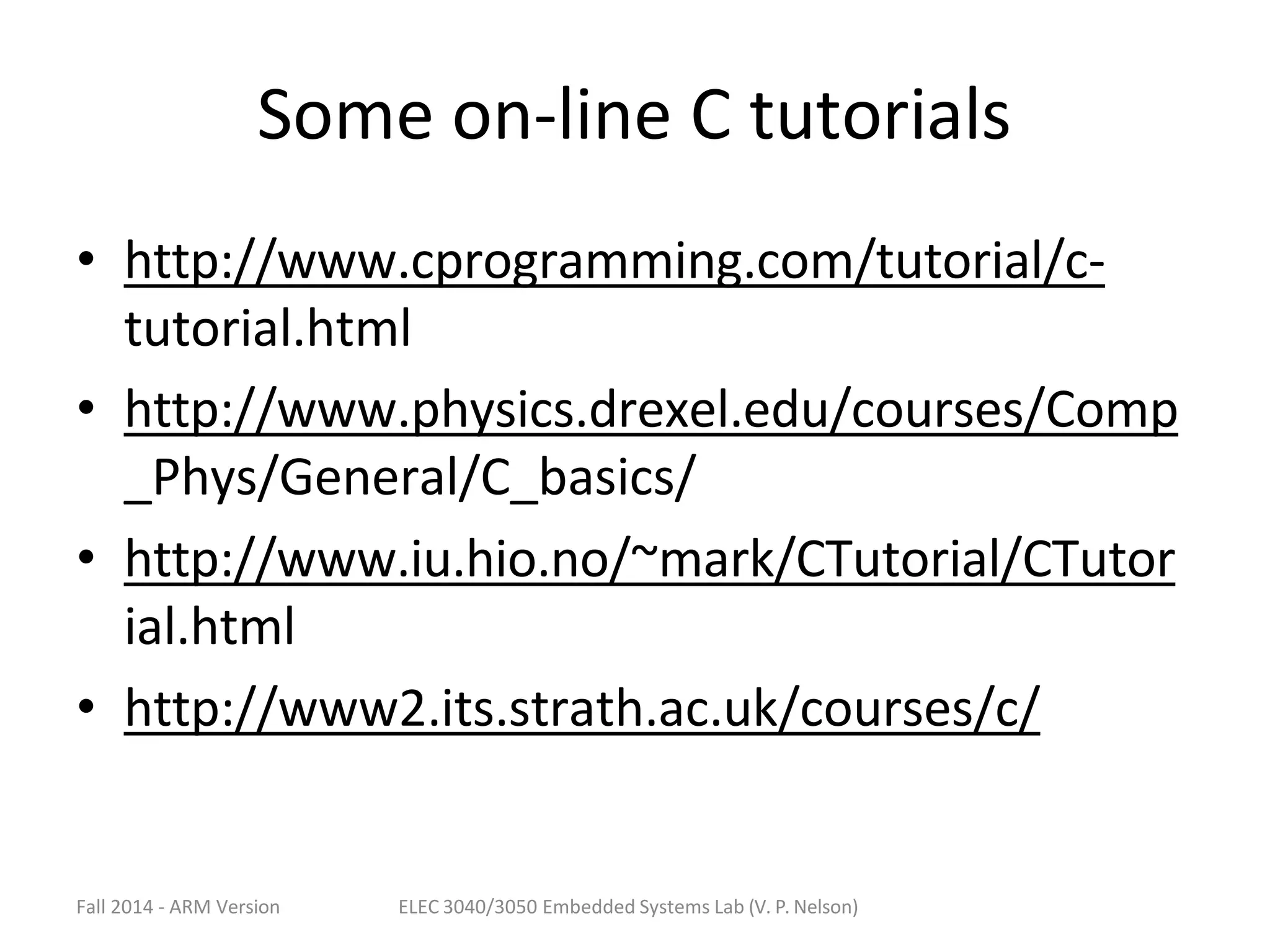This document provides an overview of C programming for embedded microcontroller systems. It discusses program structure, data types, variables, operators, control structures, functions, interrupts, and memory mapping. Specific topics covered include basic C program components and layout, microcontroller memory maps, header files, data types and sizes, constant values, variable scopes (automatic and static), arithmetic and logical operators, and basic C statement types. The intended audience is those with experience in assembly language programming who want to learn C for embedded applications.

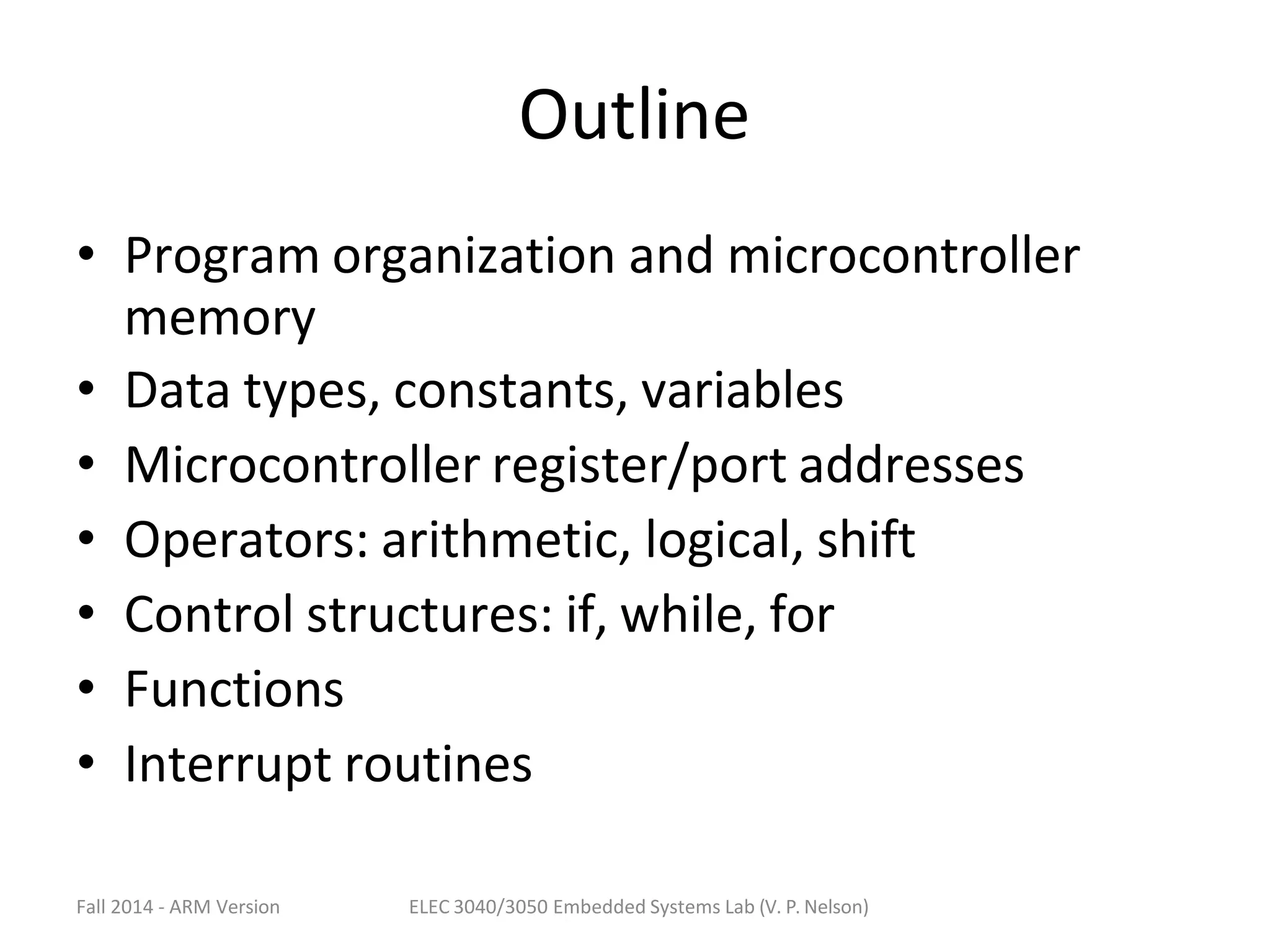
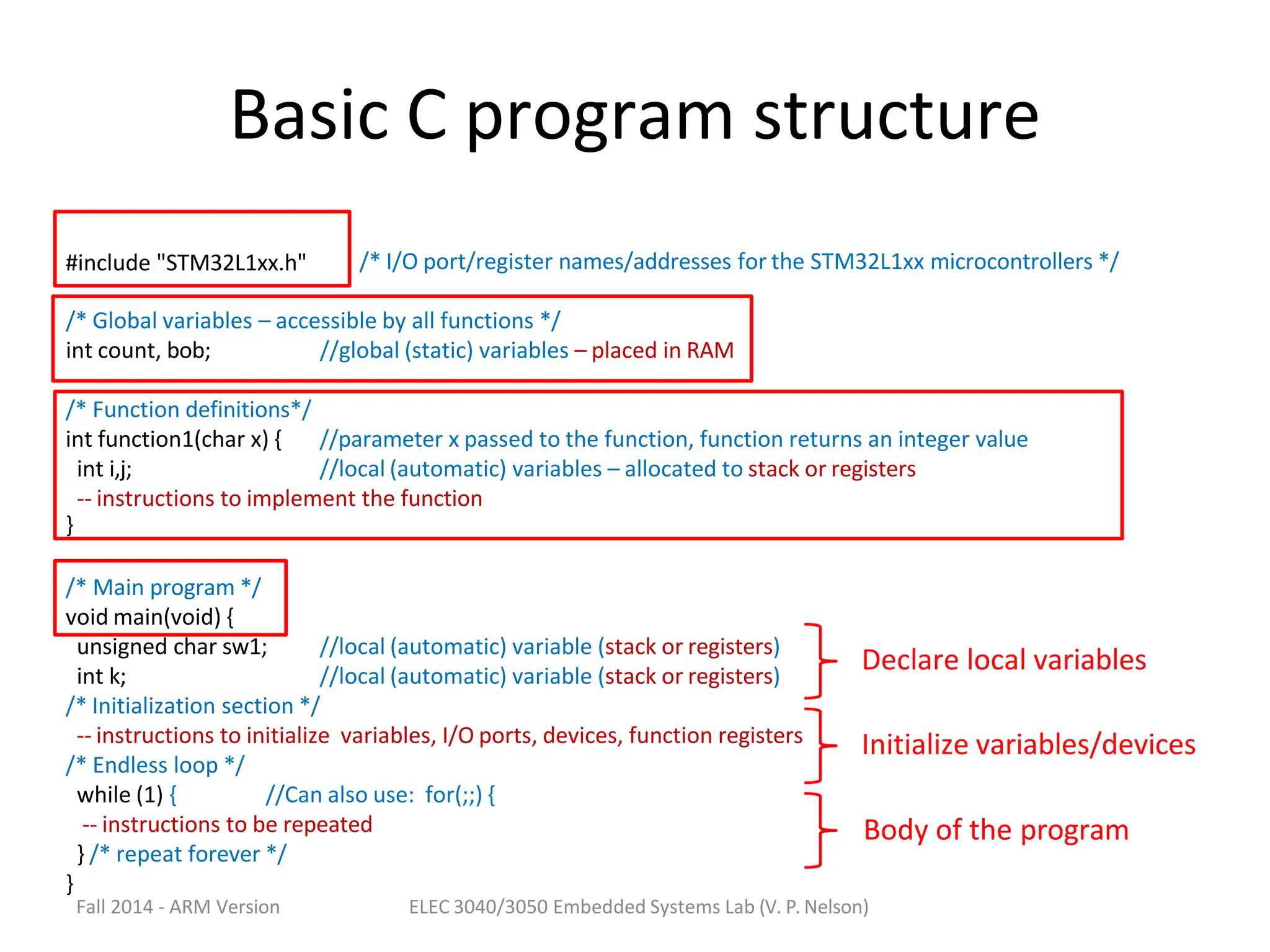
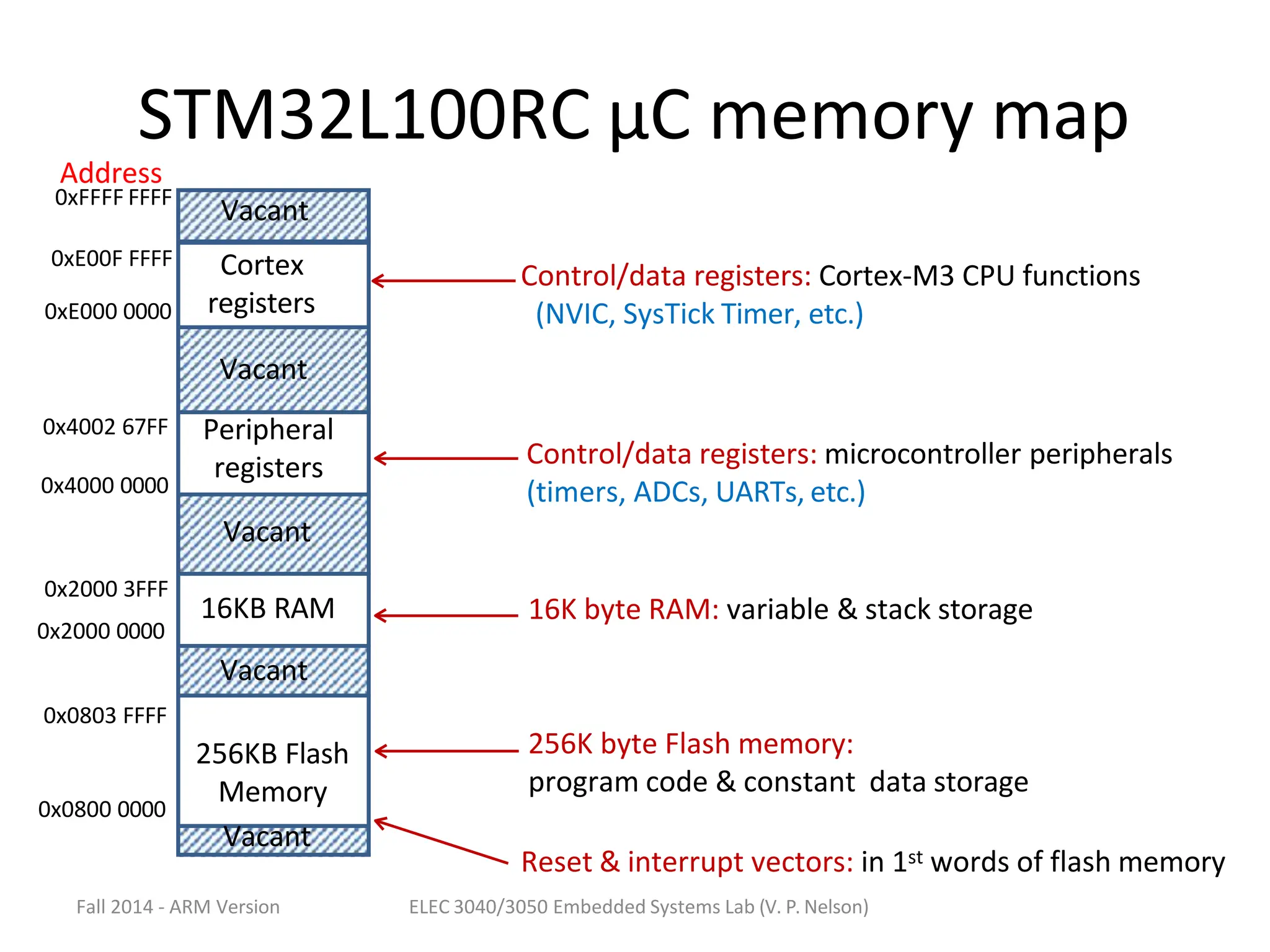
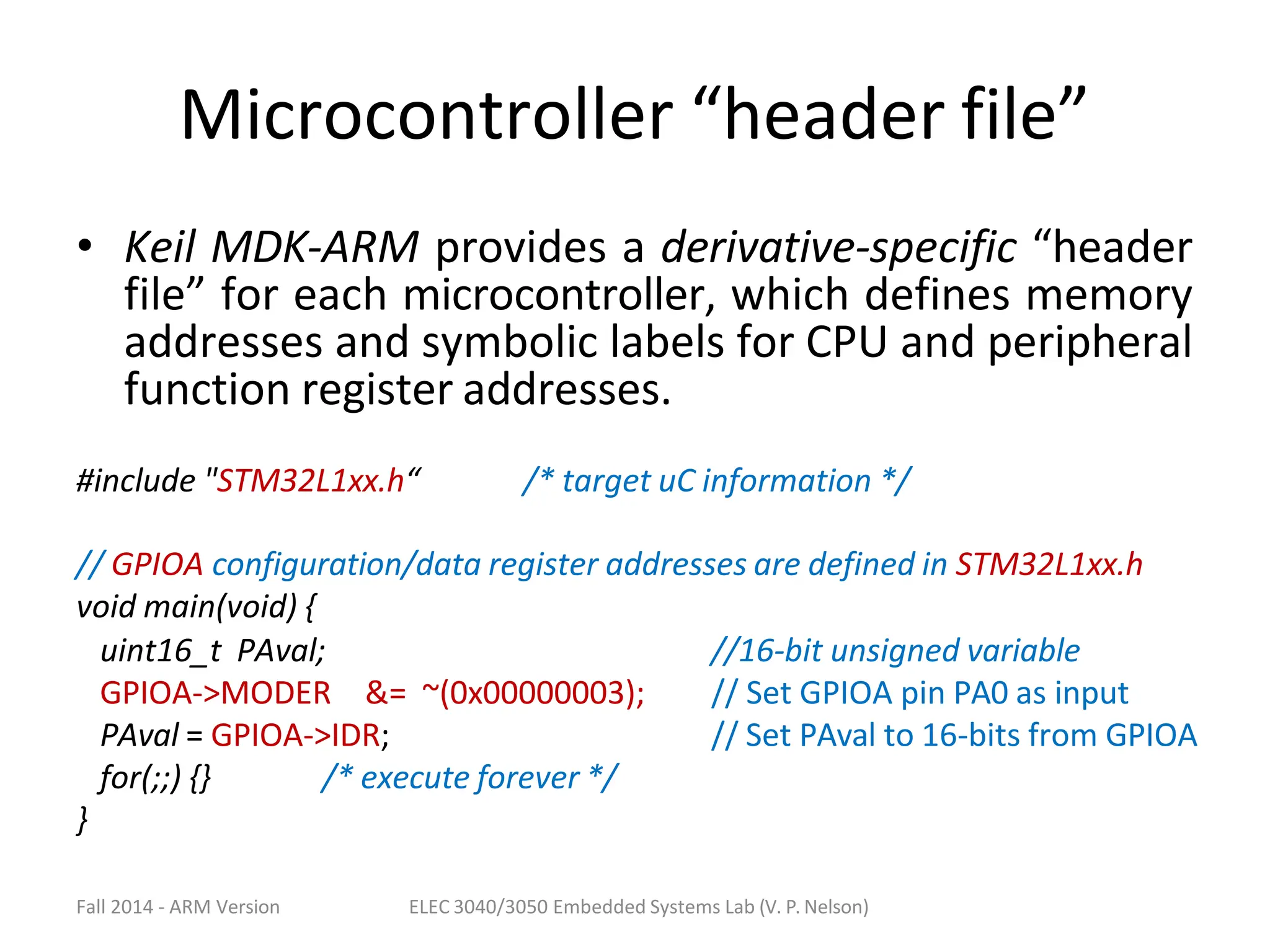
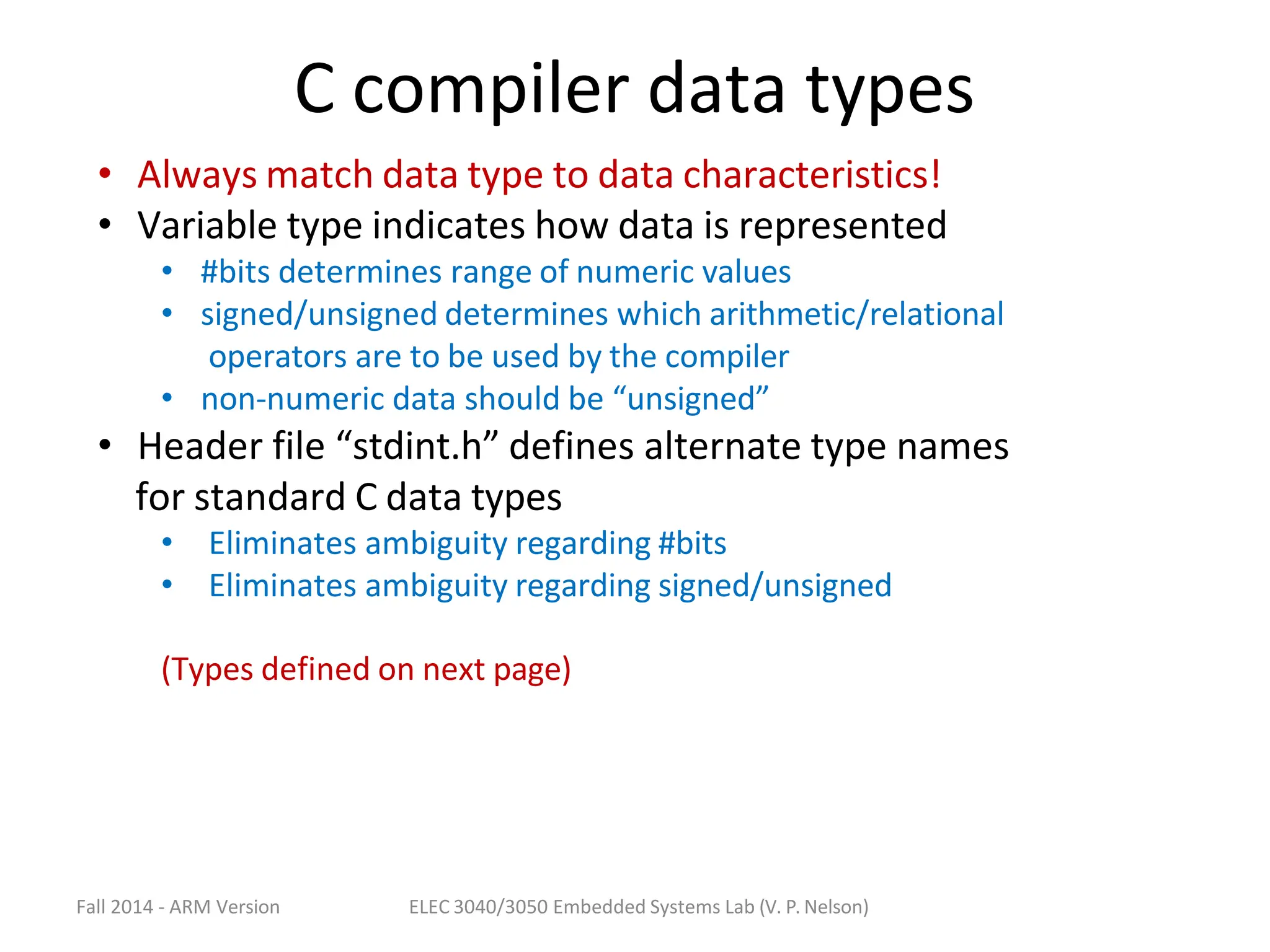
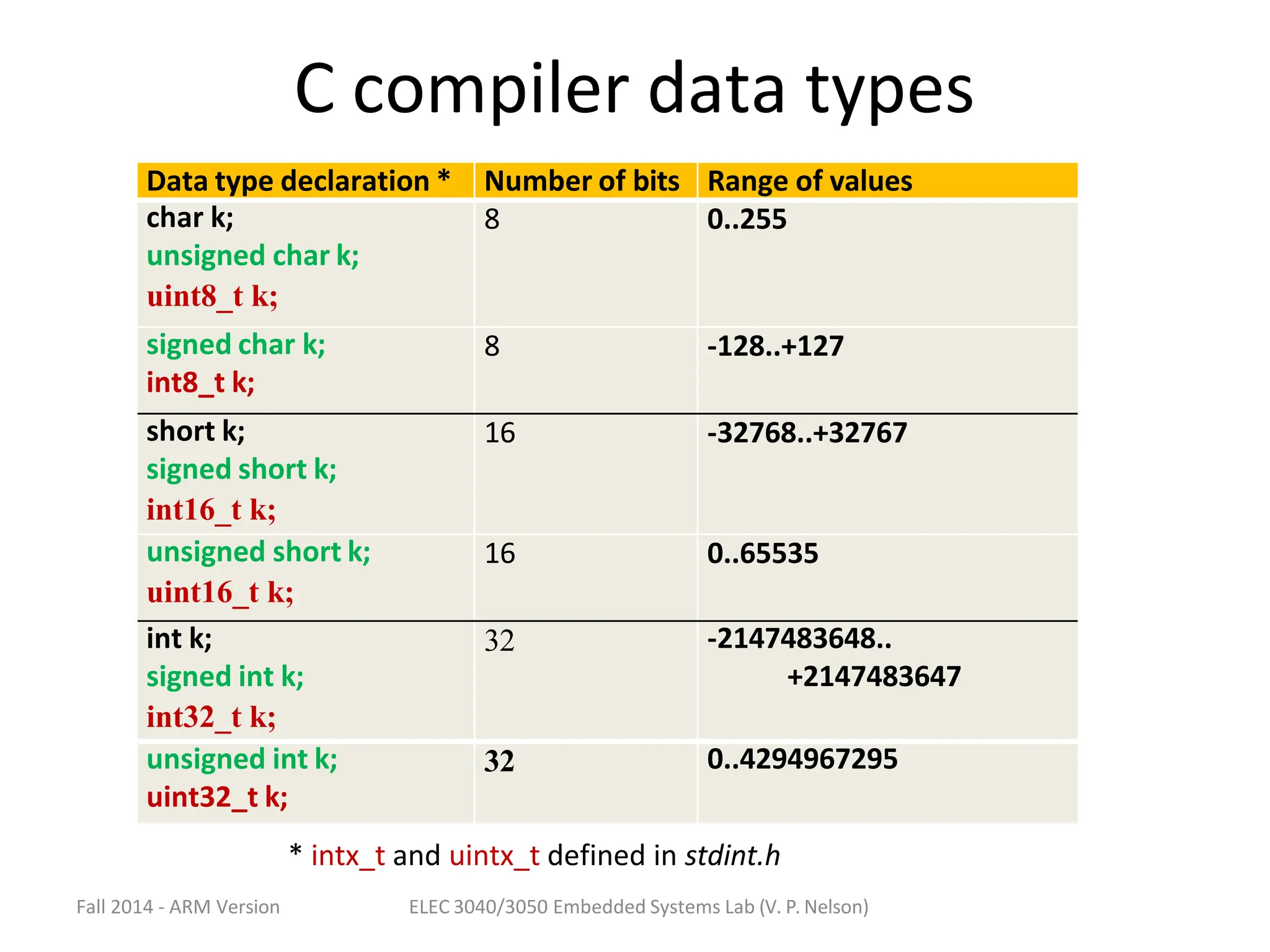
![Fall 2014 - ARM Version ELEC 3040/3050 Embedded Systems Lab (V. P. Nelson)
Data type examples
• Read bits from GPIOA (16 bits, non-numeric)
– uint16_t n; n = GPIOA->IDR; //or: unsigned short n;
• Write TIM2 prescale value (16-bit unsigned)
– uint16_t t; TIM2->PSC = t; //or: unsigned short t;
• Read 32-bit value from ADC (unsigned)
– uint32_t a; a = ADC; //or: unsigned int a;
• System control value range [-1000…+1000]
– int32_t ctrl; ctrl = (x + y)*z; //or: int ctrl;
• Loop counter for 100 program loops (unsigned)
– uint8_t cnt; //or: unsigned char cnt;
– for (cnt = 0; cnt < 20; cnt++) {](https://image.slidesharecdn.com/cprogrammingforembeddedsystemapplications-231028123916-aac2e84f/75/C-programming-for-embedded-system-applications-pptx-8-2048.jpg)
![Fall 2014 - ARM Version ELEC 3040/3050 Embedded Systems Lab (V. P. Nelson)
Constant/literal values
• Decimal is the default number format
int m,n; //16-bit signed numbers
m = 453; n = -25;
• Hexadecimal: preface value with 0x or 0X
m = 0xF312; n = -0x12E4;
• Octal: preface value with zero (0)
m = 0453; n = -023;
Don’t use leading zeros on “decimal” values. They will be interpreted as octal.
• Character: character in single quotes, or ASCII value following “slash”
m = ‘a’;
n = ‘13’;
//ASCII value 0x61
//ASCII value 13 is the “return” character
• String (array) of characters:
unsigned char k[7];
strcpy(m,“hellon”); //k[0]=‘h’, k[1]=‘e’, k[2]=‘l’, k[3]=‘l’, k[4]=‘o’,
//k[5]=13 or ‘n’ (ASCII new line character),
//k[6]=0 or ‘0’ (null character – end of string)](https://image.slidesharecdn.com/cprogrammingforembeddedsystemapplications-231028123916-aac2e84f/75/C-programming-for-embedded-system-applications-pptx-9-2048.jpg)
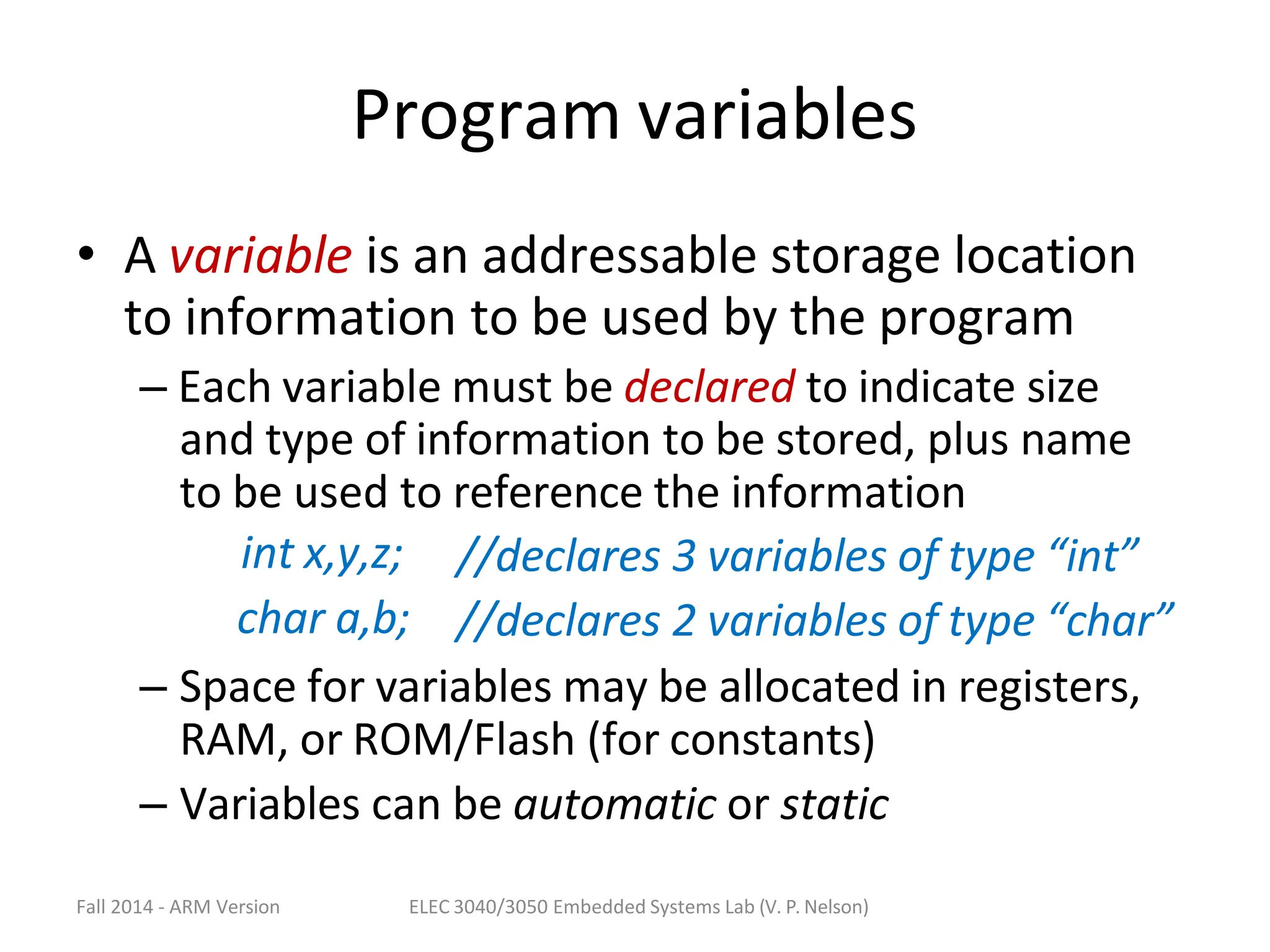
![Variable arrays
• An array is a set of data, stored in consecutive
memory locations, beginning at a named address
– Declare array name and number of data elements, N
– Elements are “indexed”, with indices [0 .. N-1]
int n[5];
n[3] = 5;
//declare array of 5 “int” values
//set value of 4th array element
n[0]
n[1]
n[2]
n[3]
n[4]
Address:
n
n+4
n+8
n+12
n+16
Note: Index of first element is always 0.
Fall 2014 - ARM Version ELEC 3040/3050 Embedded Systems Lab (V. P. Nelson)](https://image.slidesharecdn.com/cprogrammingforembeddedsystemapplications-231028123916-aac2e84f/75/C-programming-for-embedded-system-applications-pptx-11-2048.jpg)
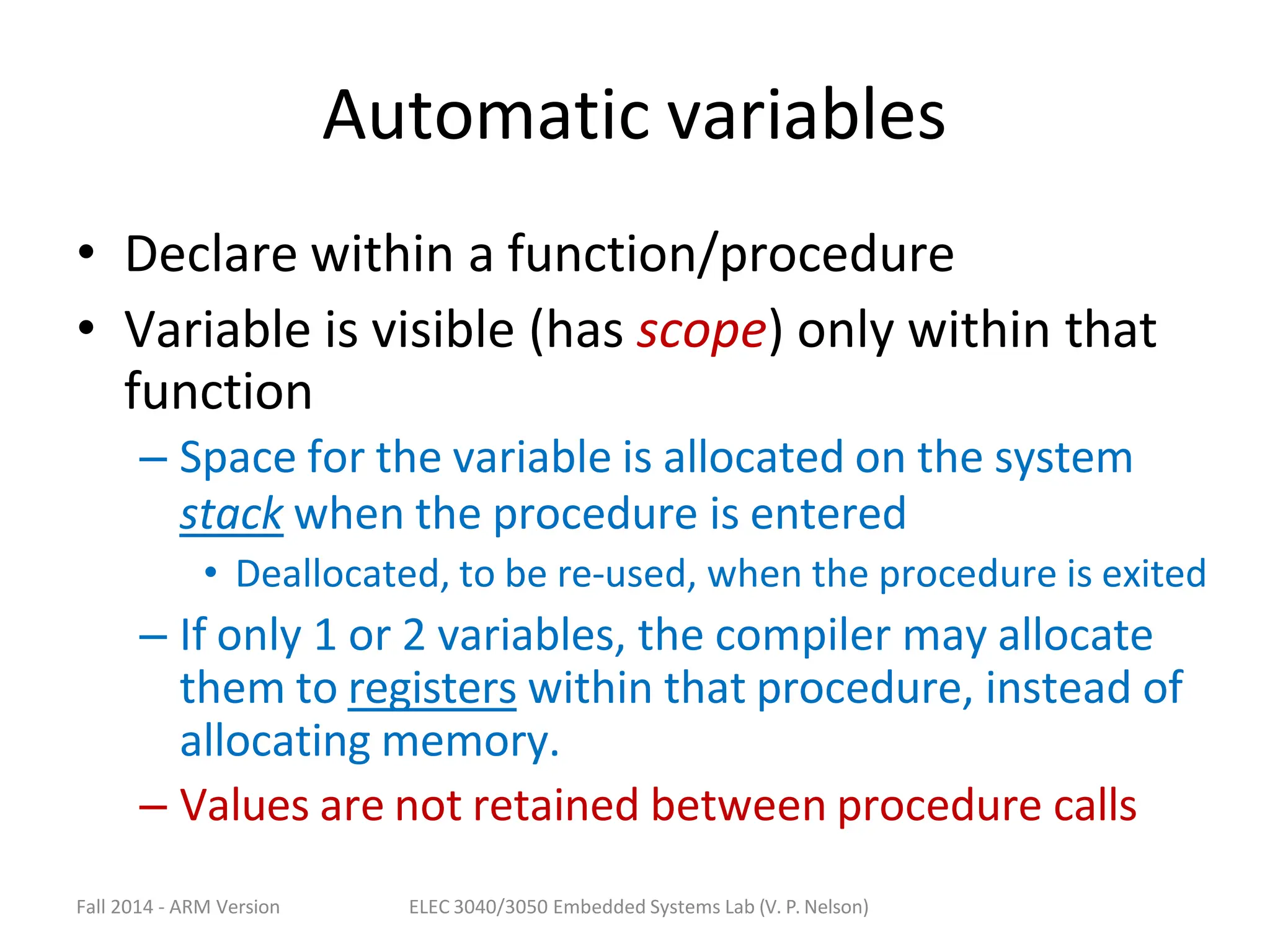
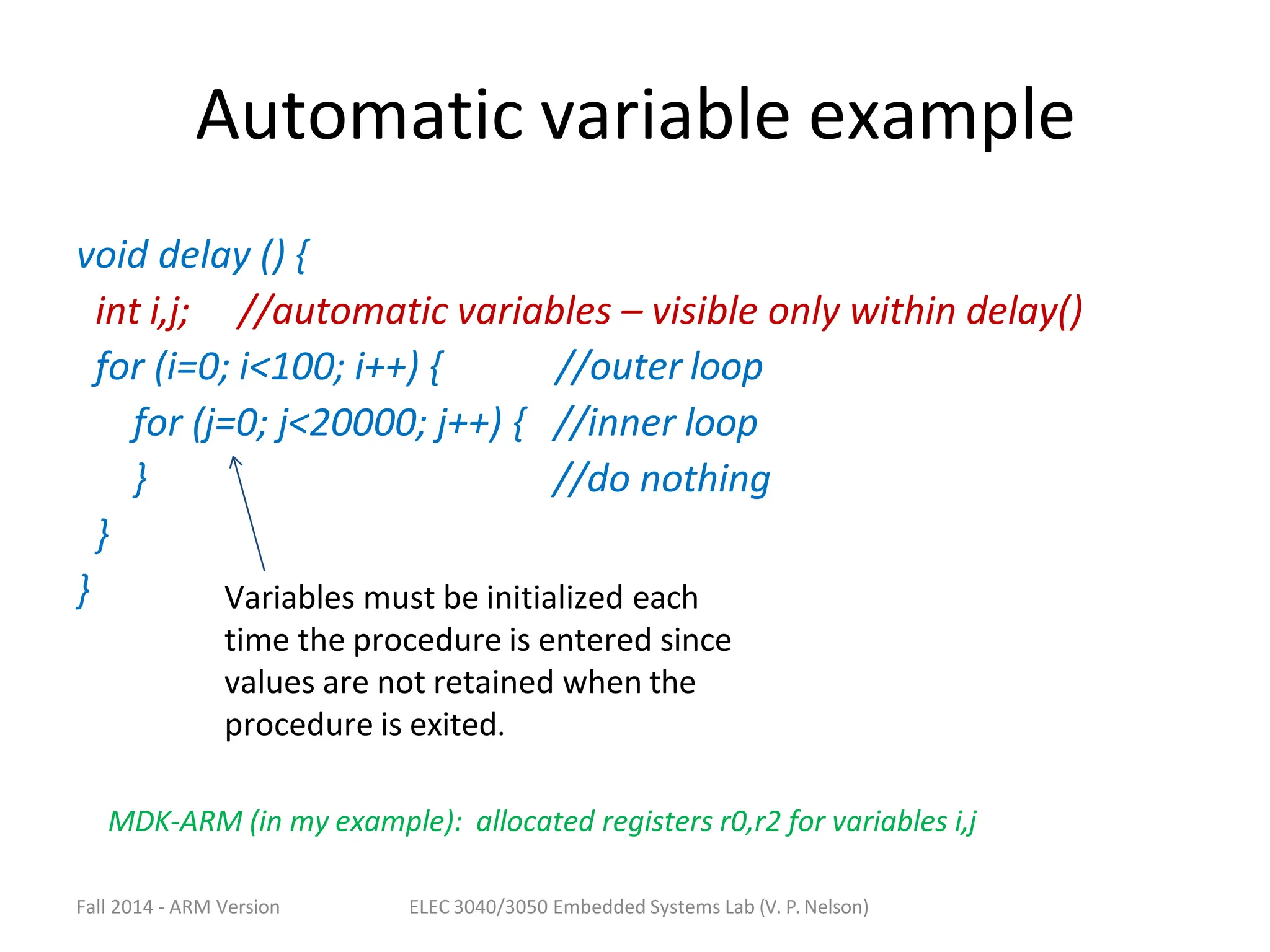
![Fall 2014 - ARM Version ELEC 3040/3050 Embedded Systems Lab (V. P. Nelson)
Static variables
• Retained for use throughout the program in RAM
locations that are not reallocated during program
execution.
• Declare either within or outside of a function
– If declared outside a function, the variable is global in scope,
i.e. known to all functions of the program
• Use “normal” declarations. Example: int count;
– If declared within a function, insert key word static before
the variable definition. The variable is local in scope, i.e.
known only within this function.
static unsigned char bob;
static int pressure[10];](https://image.slidesharecdn.com/cprogrammingforembeddedsystemapplications-231028123916-aac2e84f/75/C-programming-for-embedded-system-applications-pptx-14-2048.jpg)
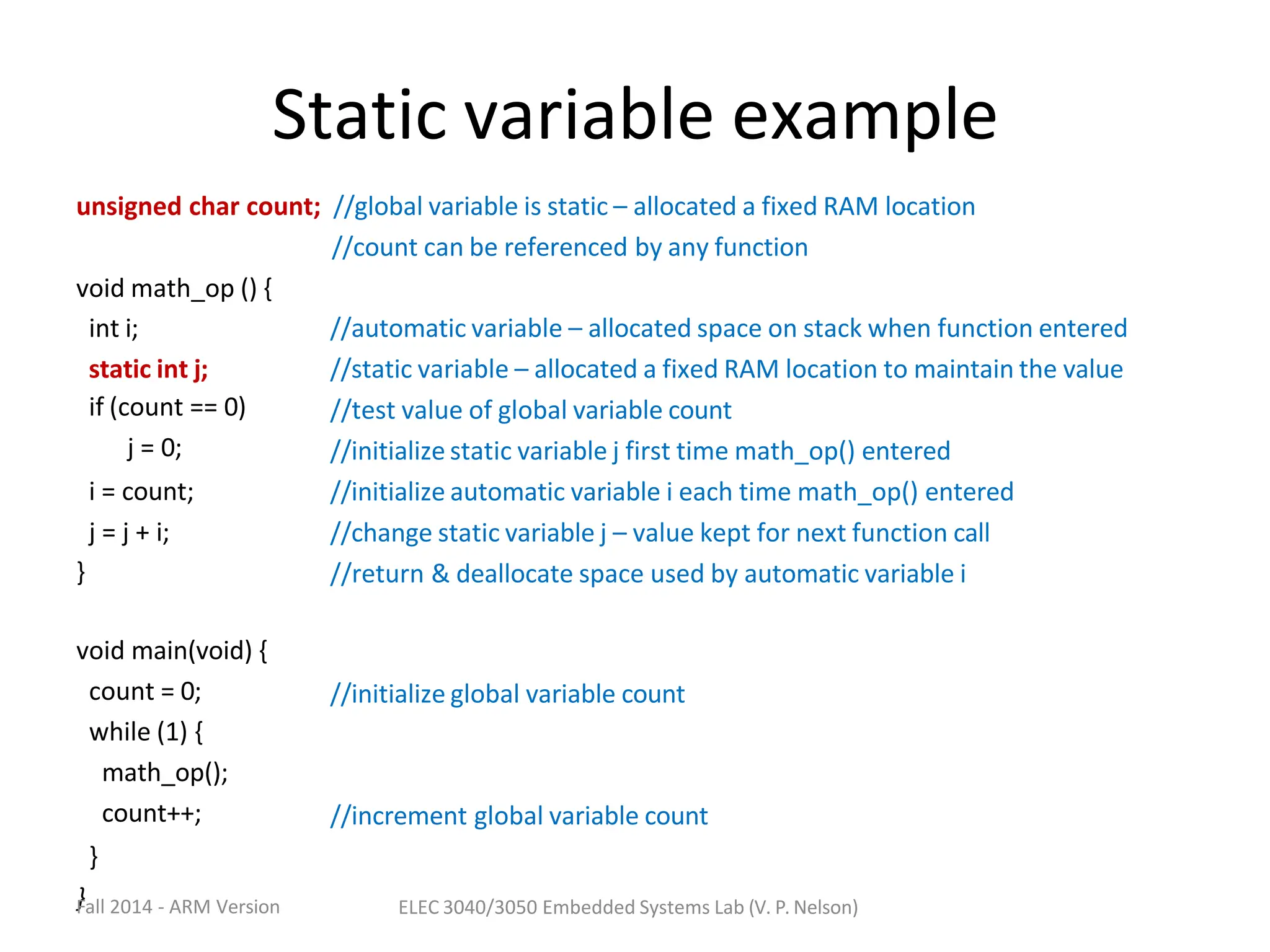

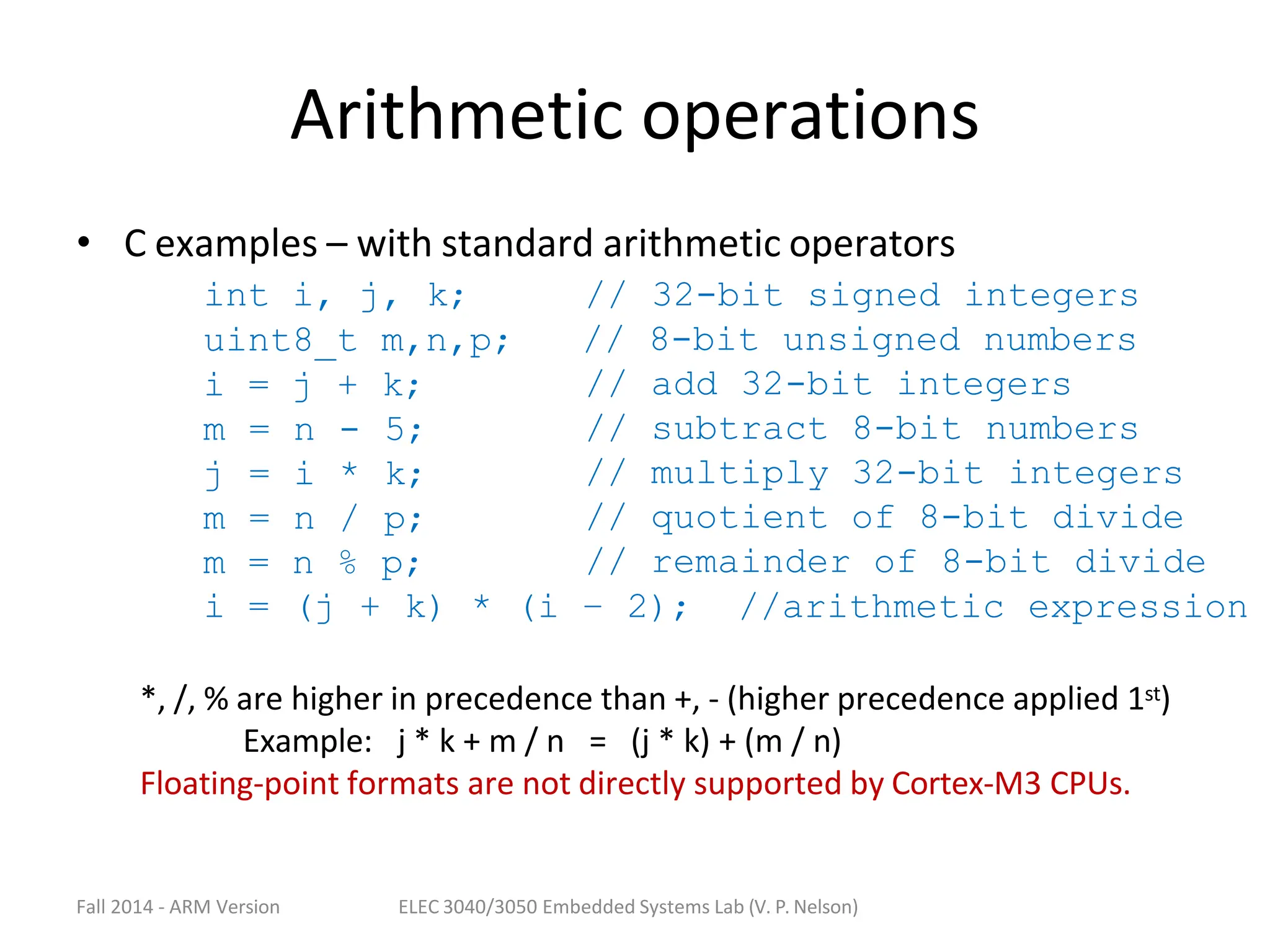
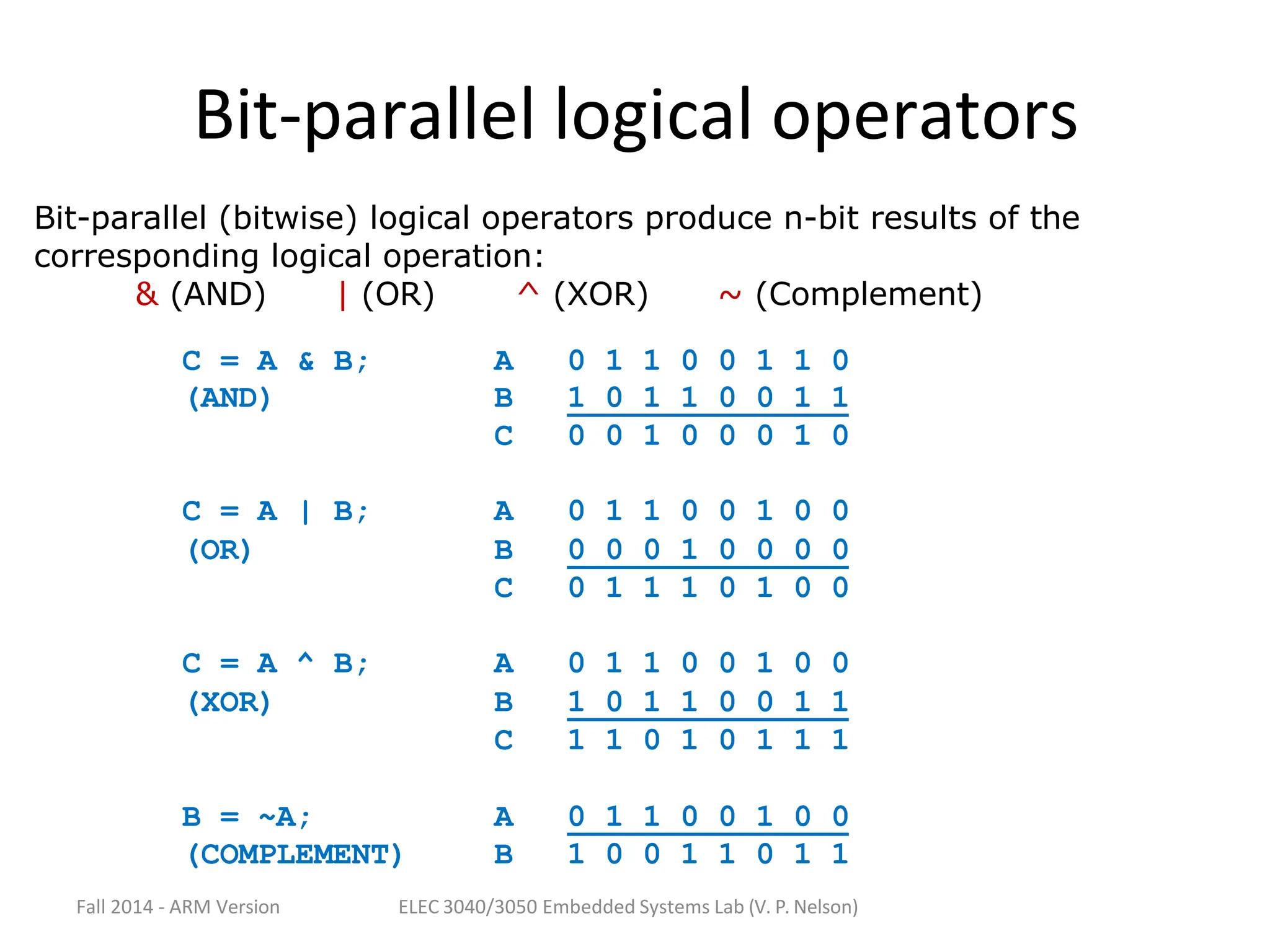

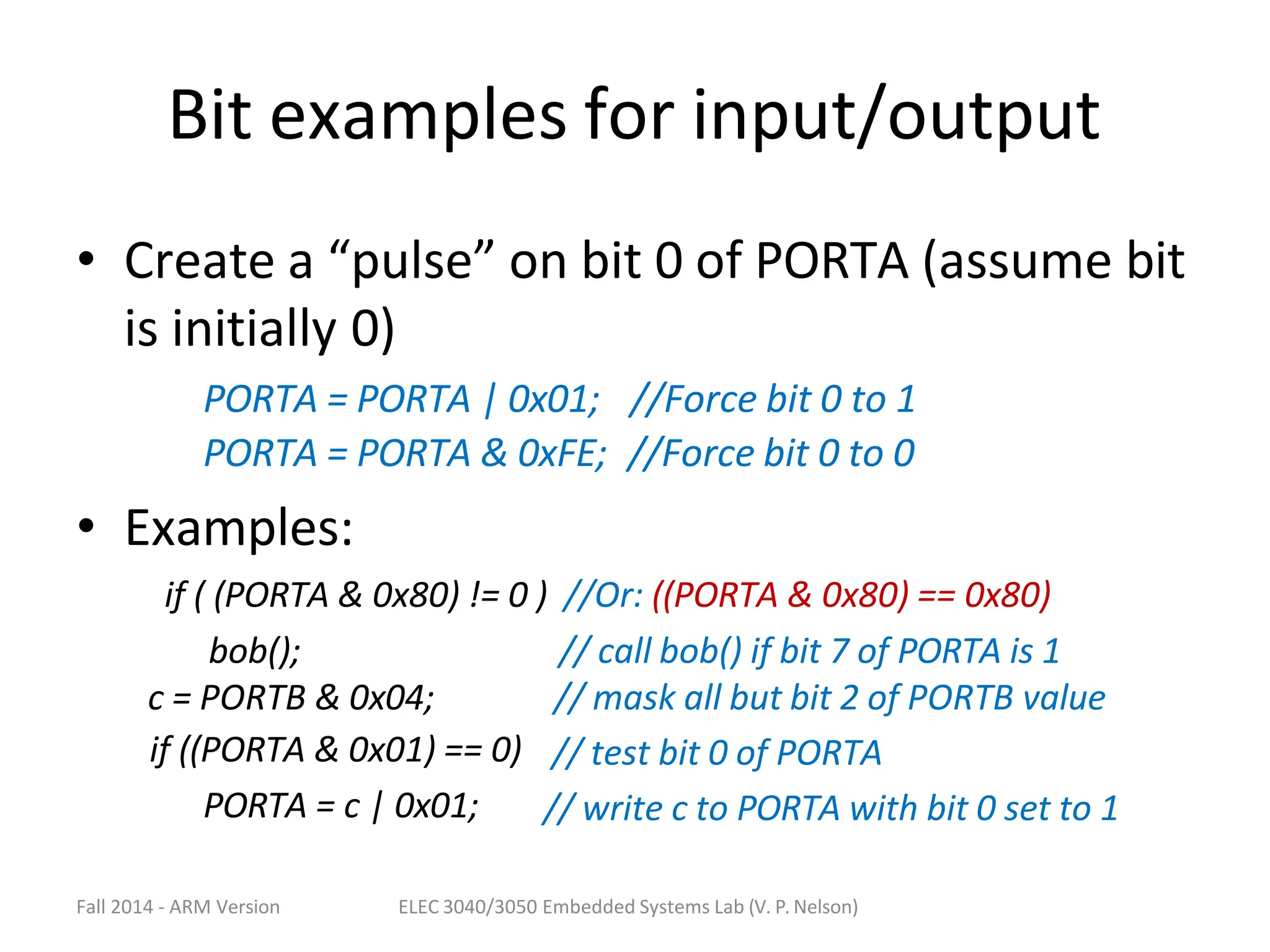
![Fall 2014 - ARM Version ELEC 3040/3050 Embedded Systems Lab (V. P. Nelson)
Example of µC register address definitions in STM32Lxx.h
(read this header file to view other peripheral functions)
#define PERIPH_BASE ((uint32_t)0x40000000) //Peripheral base address in memory
#define AHBPERIPH_BASE (PERIPH_BASE + 0x20000) //AHB peripherals
/* Base addresses of blocks of GPIO control/data registers */
#define GPIOA_BASE (AHBPERIPH_BASE + 0x0000) //Registers for GPIOA
#define GPIOB_BASE (AHBPERIPH_BASE + 0x0400) //Registers for GPIOB
#define GPIOA ((GPIO_TypeDef *) GPIOA_BASE) //Pointer to GPIOA register block
#define GPIOB ((GPIO_TypeDef *) GPIOB_BASE) //Pointer to GPIOB register block
/* Address offsets from GPIO base address – block of registers defined as a “structure” */
typedef struct
{
Address offset: 0x00
Address offset: 0x04
0x06
Address offset: 0x08
Address offset: 0x0C
Address offset: 0x10
0x12
Address offset: 0x14
0x16
Address offset: 0x18
Address offset: 0x1A
Address offset: 0x1C
*/
*/
*/
*/
*/
*/
*/
*/
*/
*/
*/
*/
/*!< GPIO port mode register,
/*!< GPIO port output type register,
/*!< Reserved,
/*!< GPIO port output speed register,
/*!< GPIO port pull-up/pull-down register,
/*!< GPIO port input data register,
/*!< Reserved,
/*!< GPIO port output data register,
/*!< Reserved,
/*!< GPIO port bit set/reset low registerBSRR,
/*!< GPIO port bit set/reset high registerBSRR,
/*!< GPIO port configuration lock register,
/*!< GPIO alternate function low register, Address offset: 0x20-0x24 */
IO uint32_t MODER;
IO uint16_t OTYPER;
uint16_t RESERVED0;
IO uint32_t OSPEEDR;
IO uint32_t PUPDR;
IO uint16_t IDR;
uint16_t RESERVED1;
IO uint16_t ODR;
uint16_t RESERVED2;
IO uint16_t BSRRL;
IO uint16_t BSRRH;
IO uint32_t LCKR;
IO uint32_t AFR[2];
} GPIO_TypeDef;](https://image.slidesharecdn.com/cprogrammingforembeddedsystemapplications-231028123916-aac2e84f/75/C-programming-for-embedded-system-applications-pptx-21-2048.jpg)
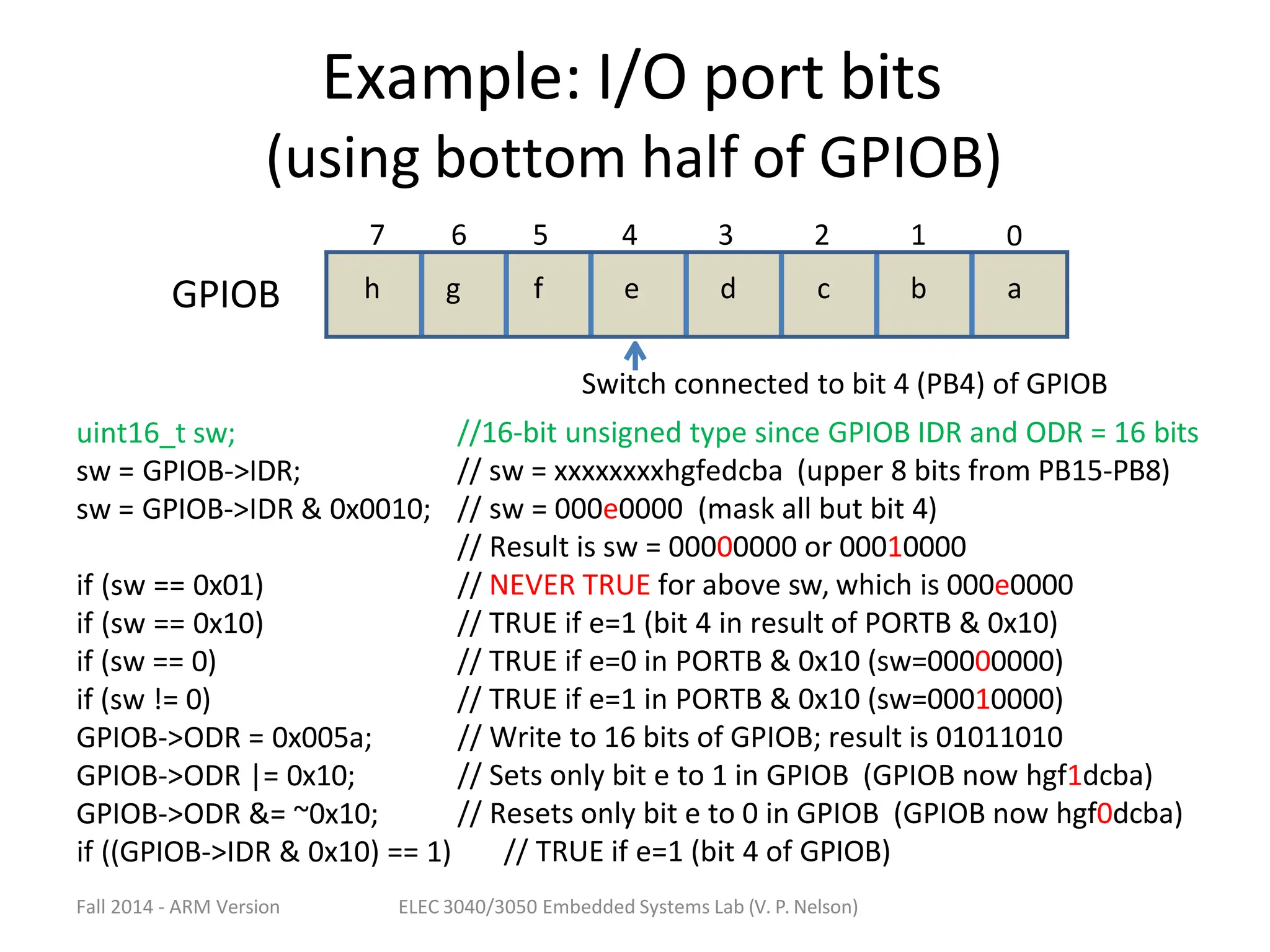
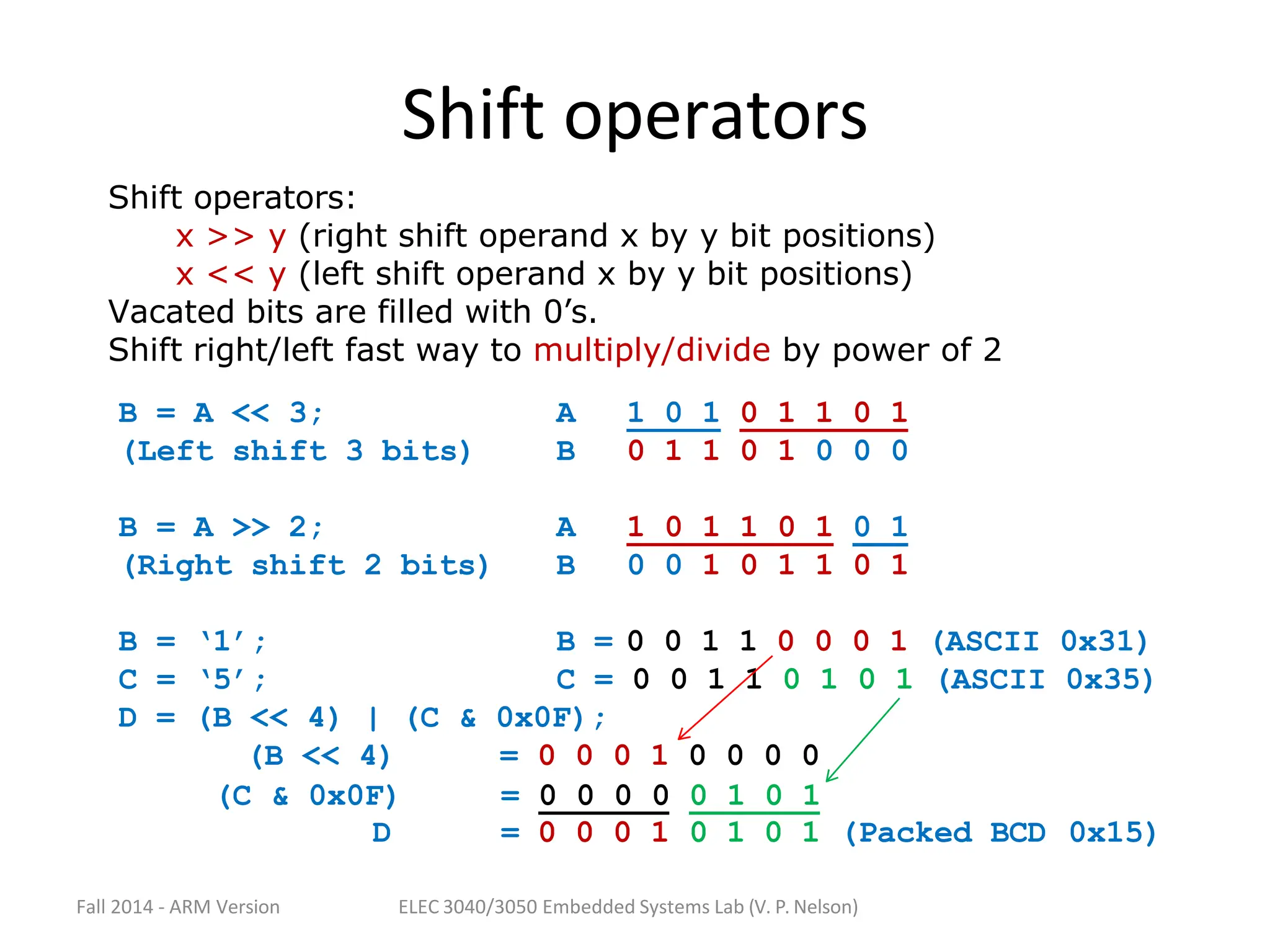
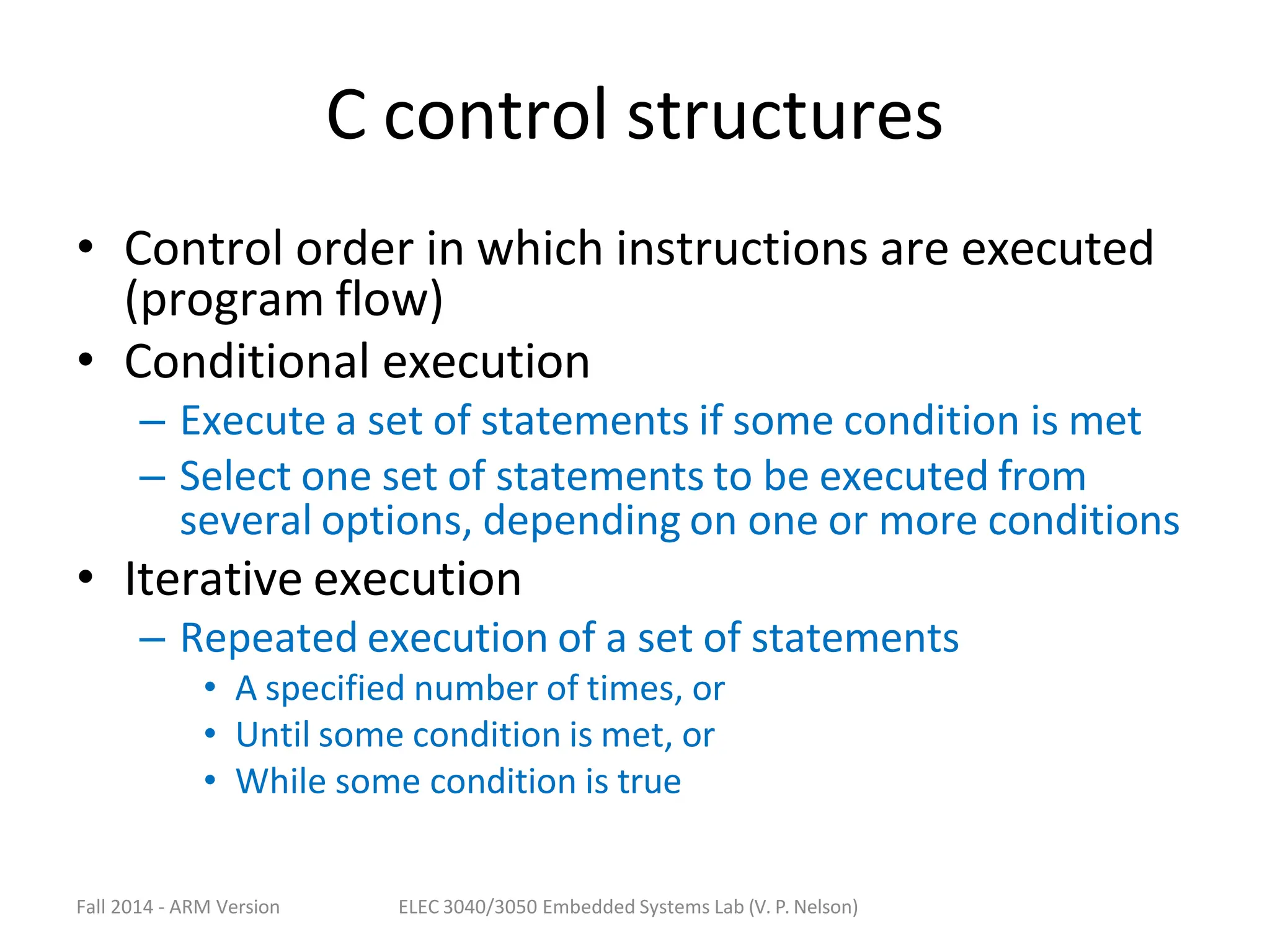
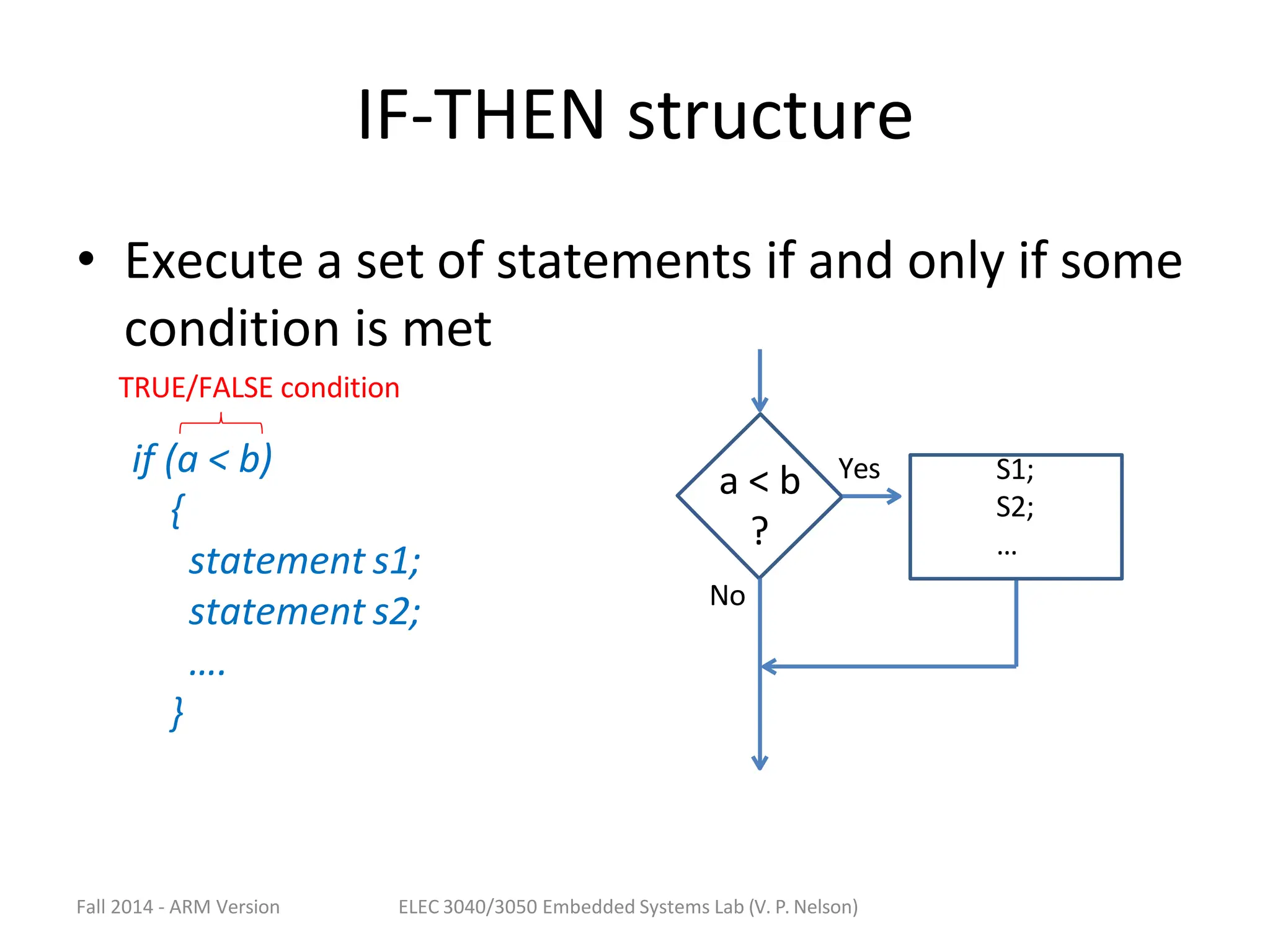

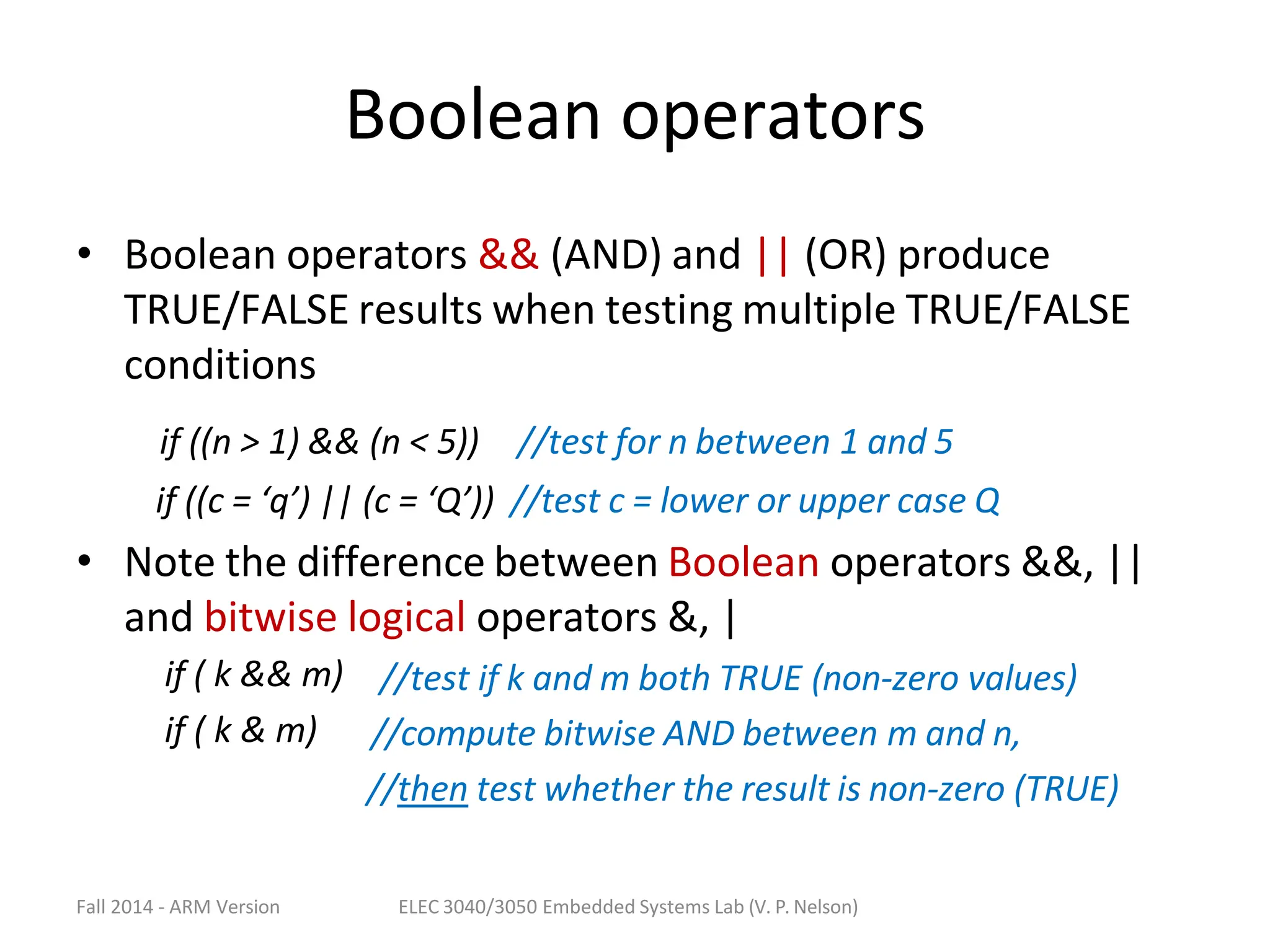
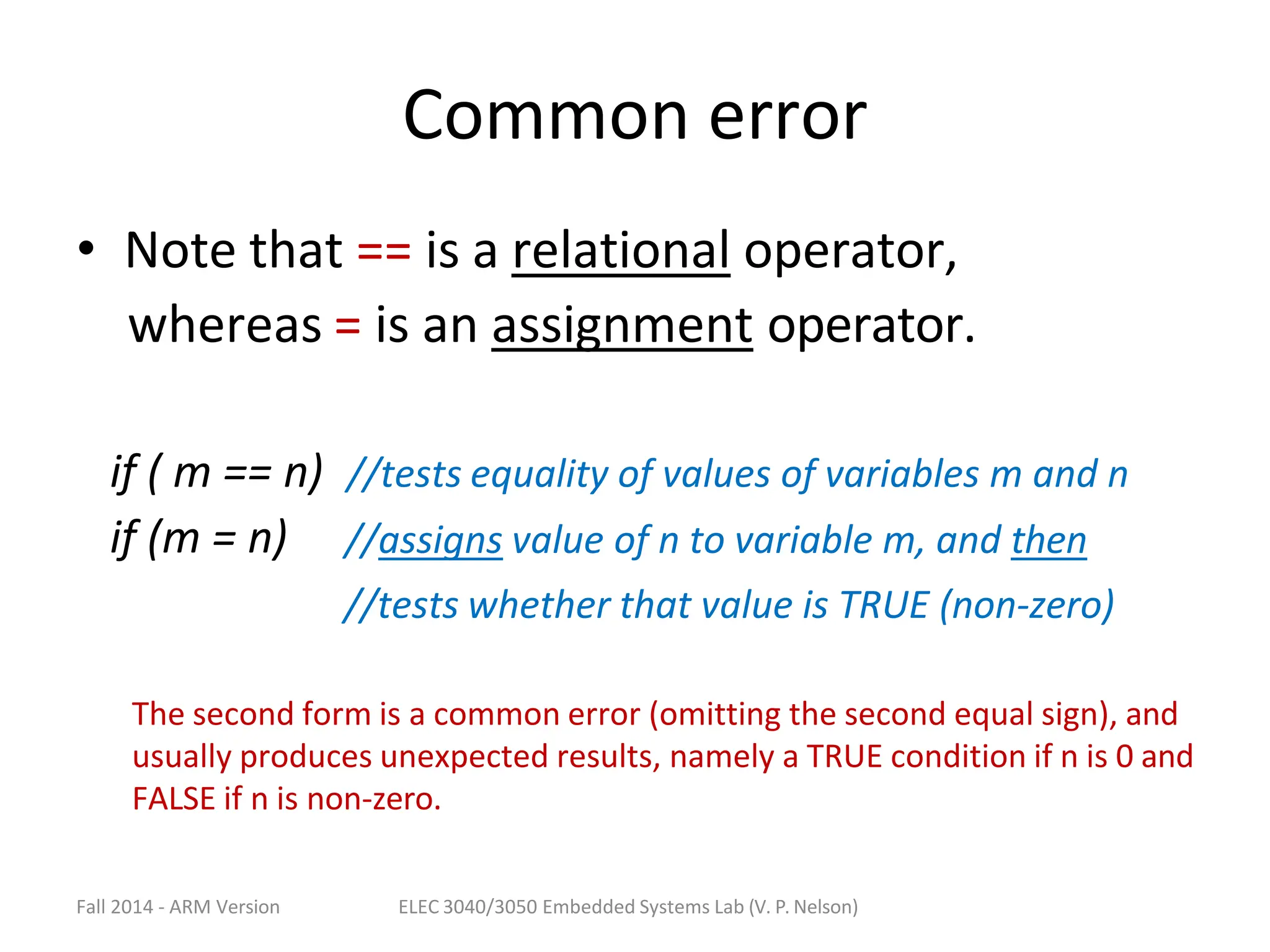
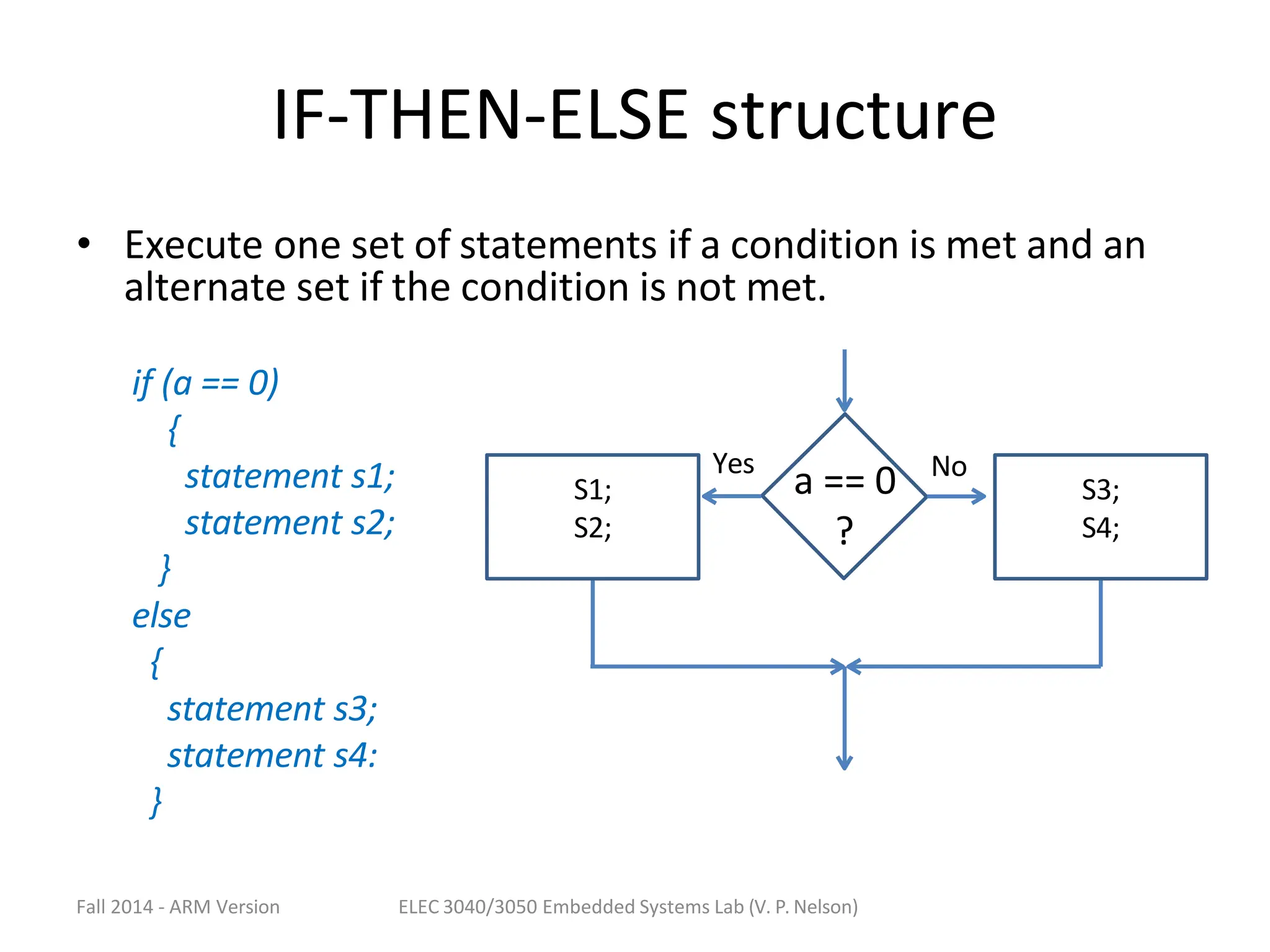
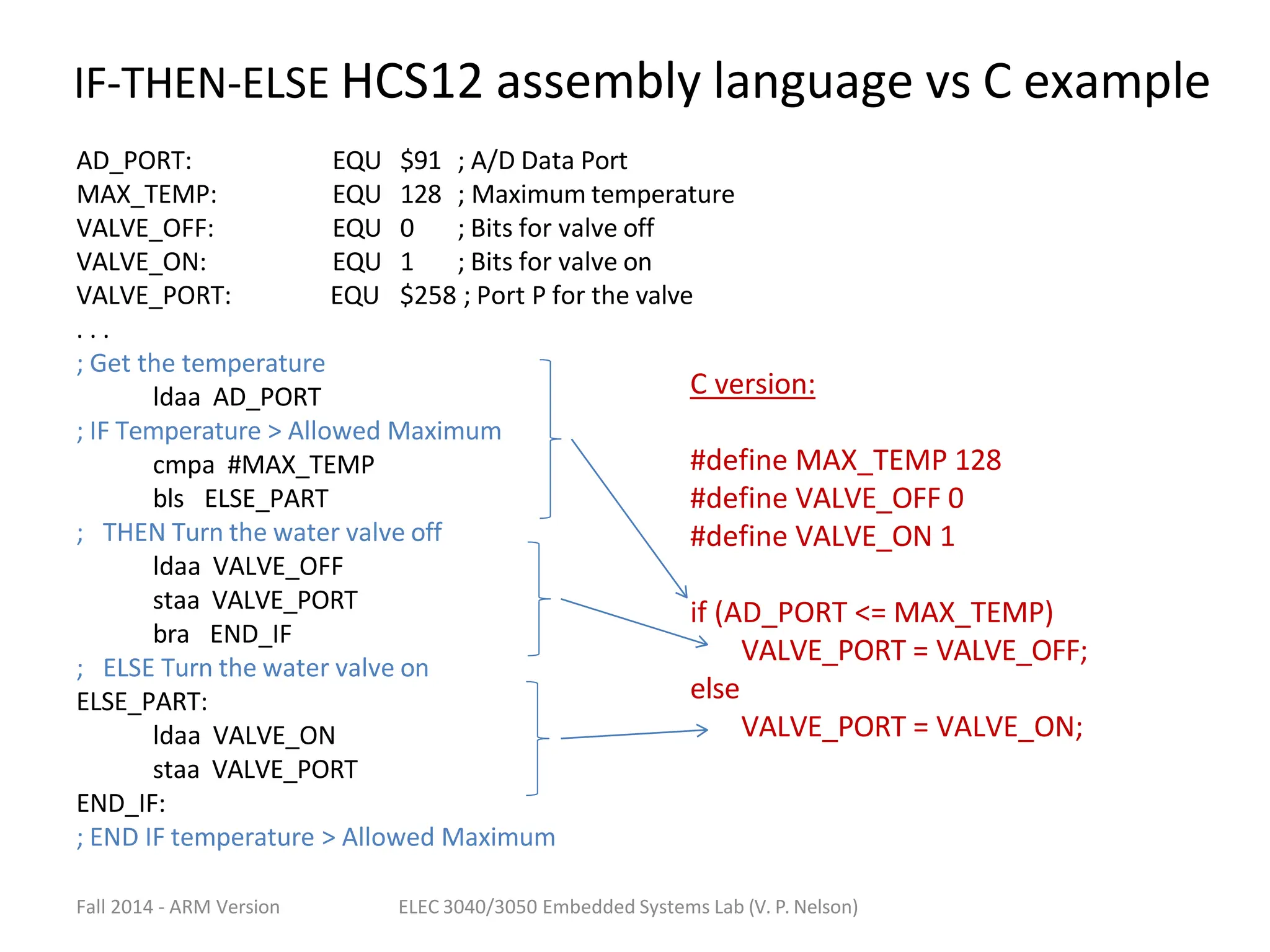
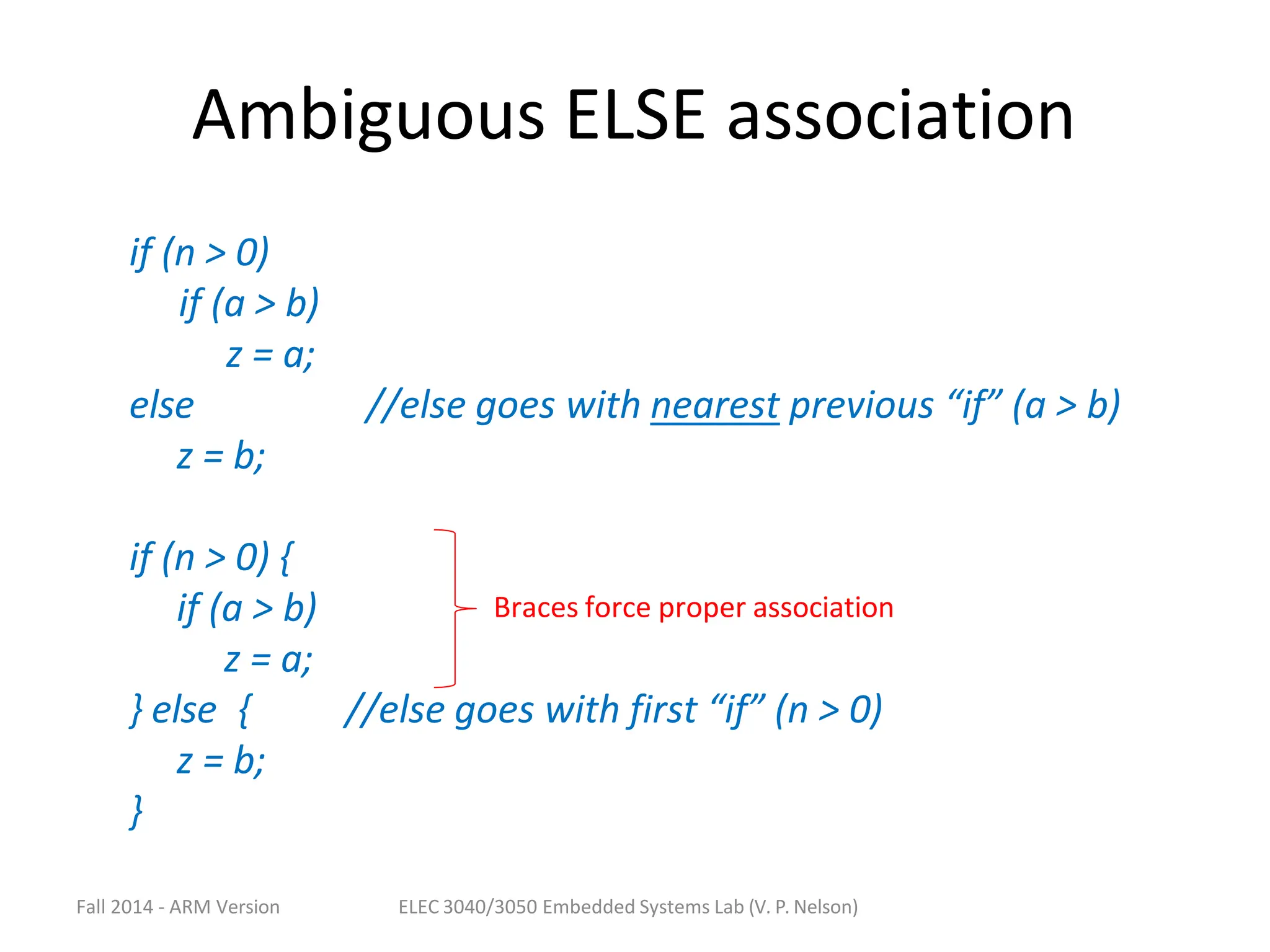
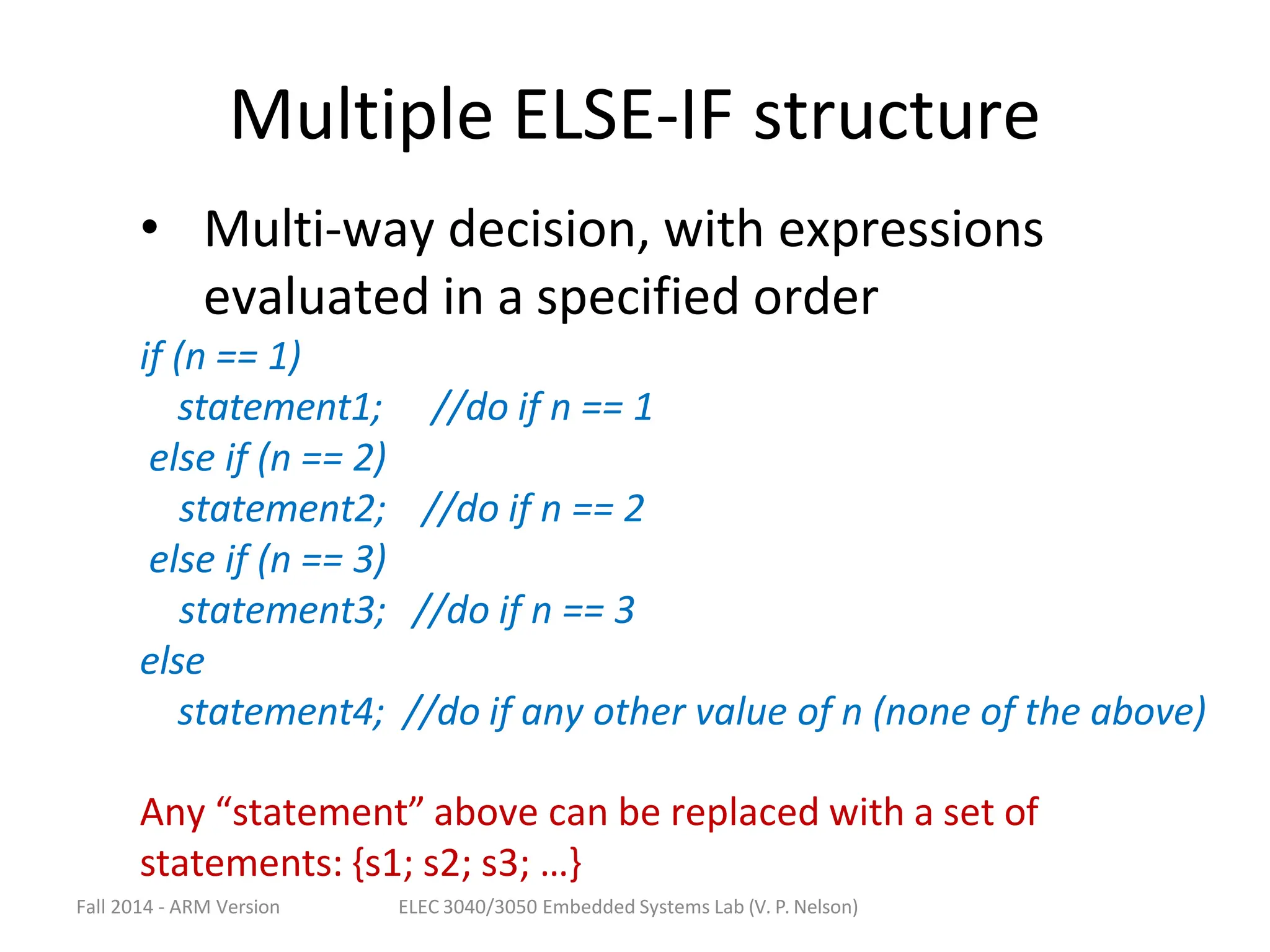
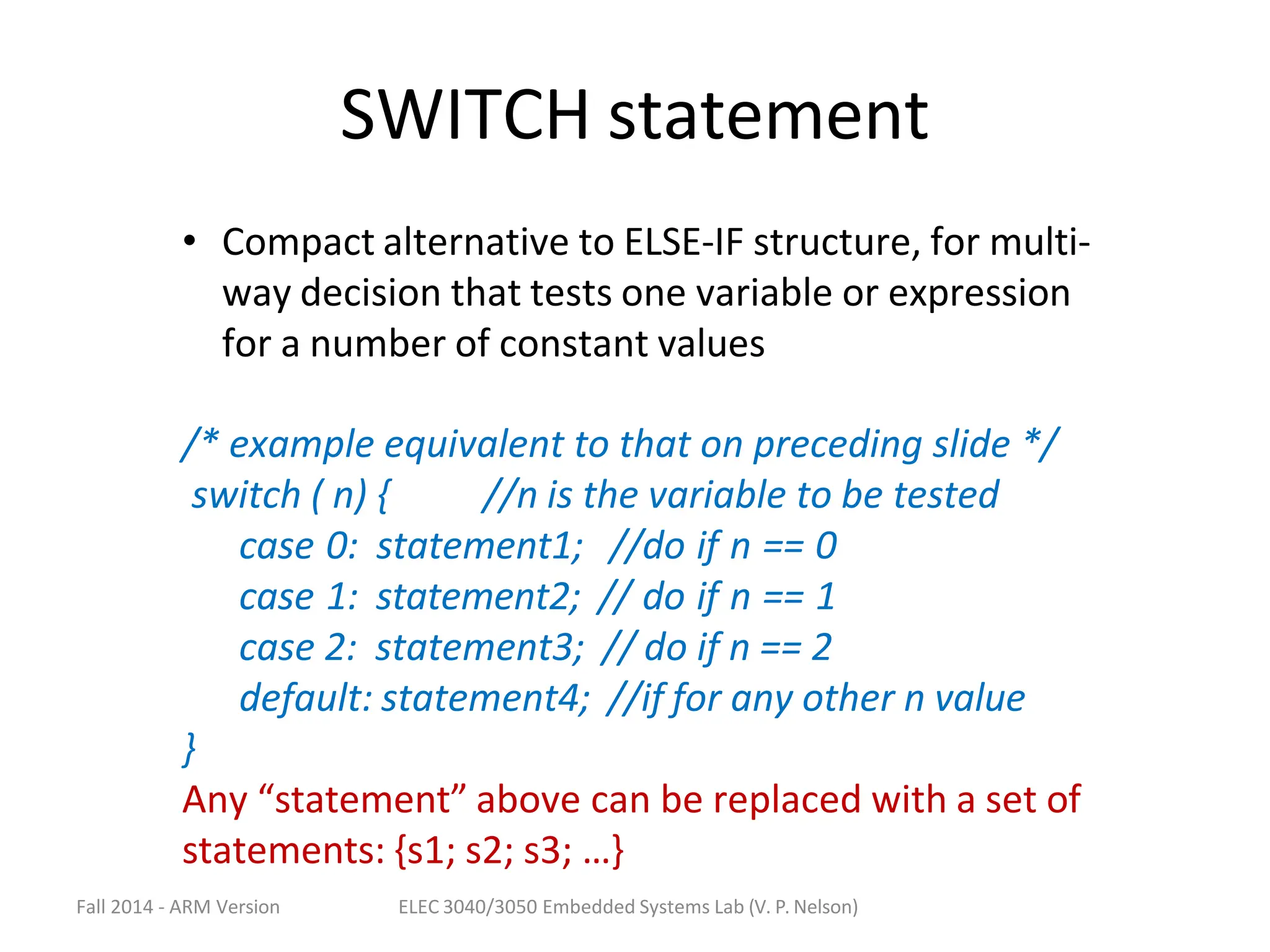
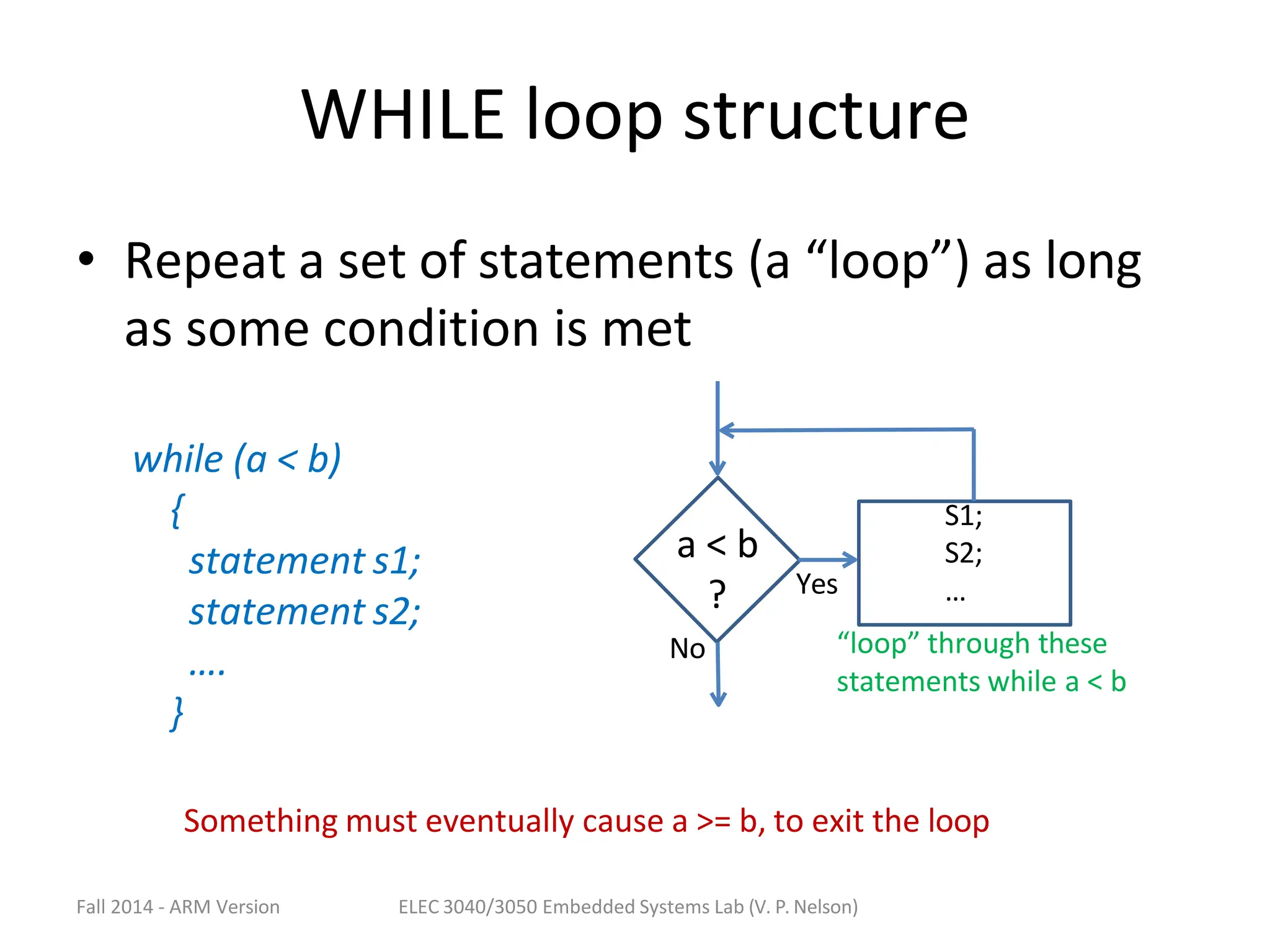
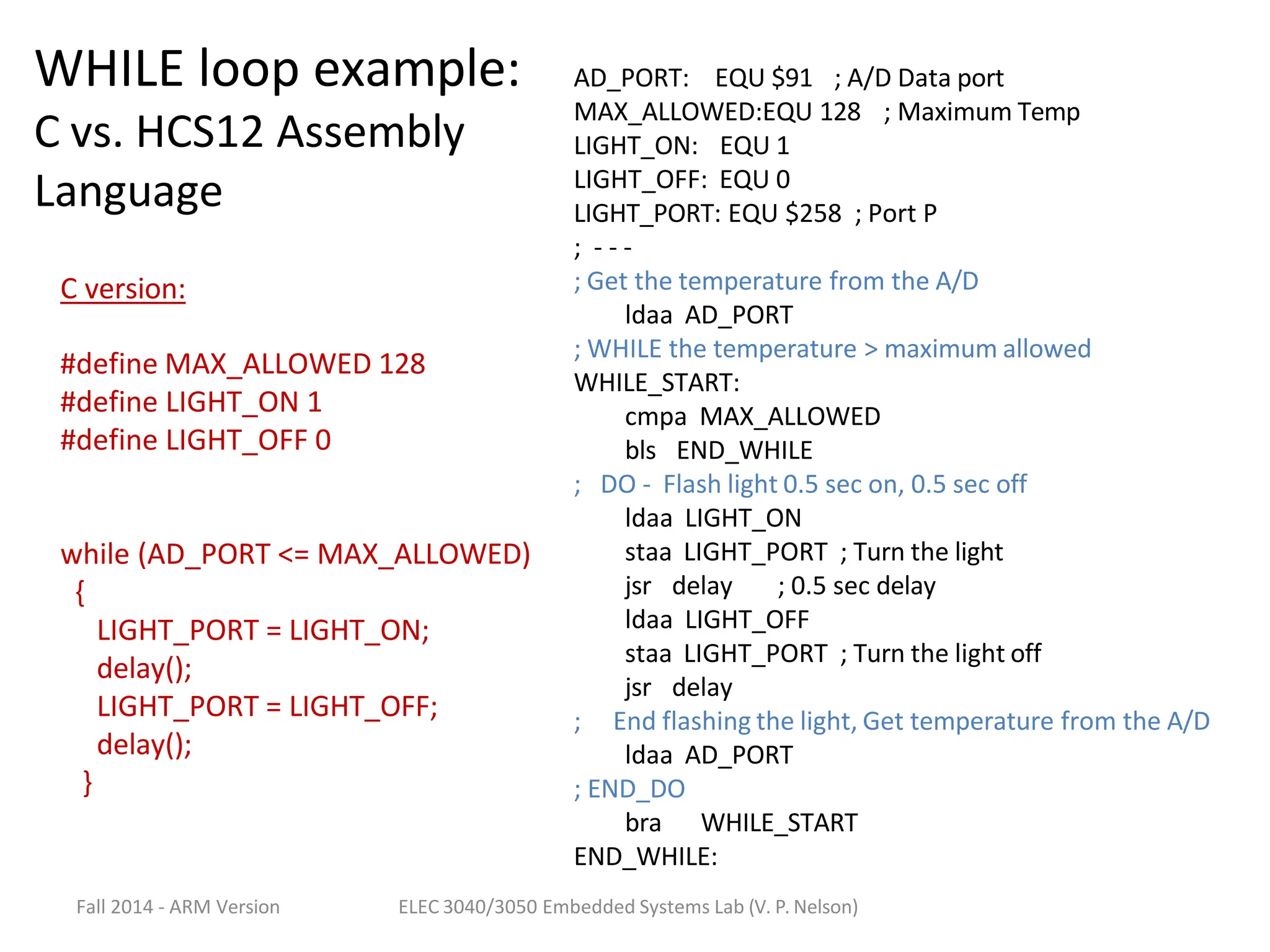
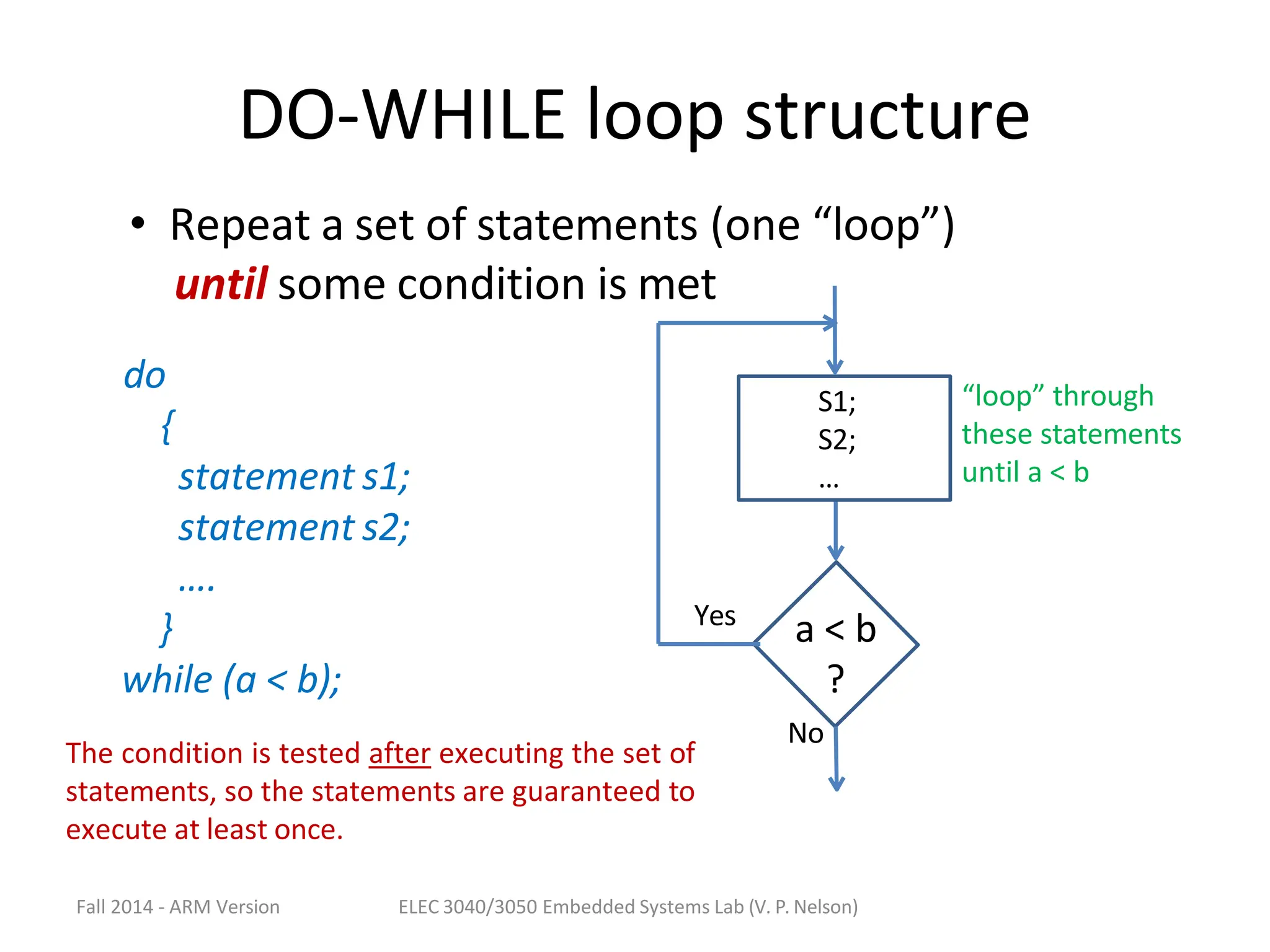
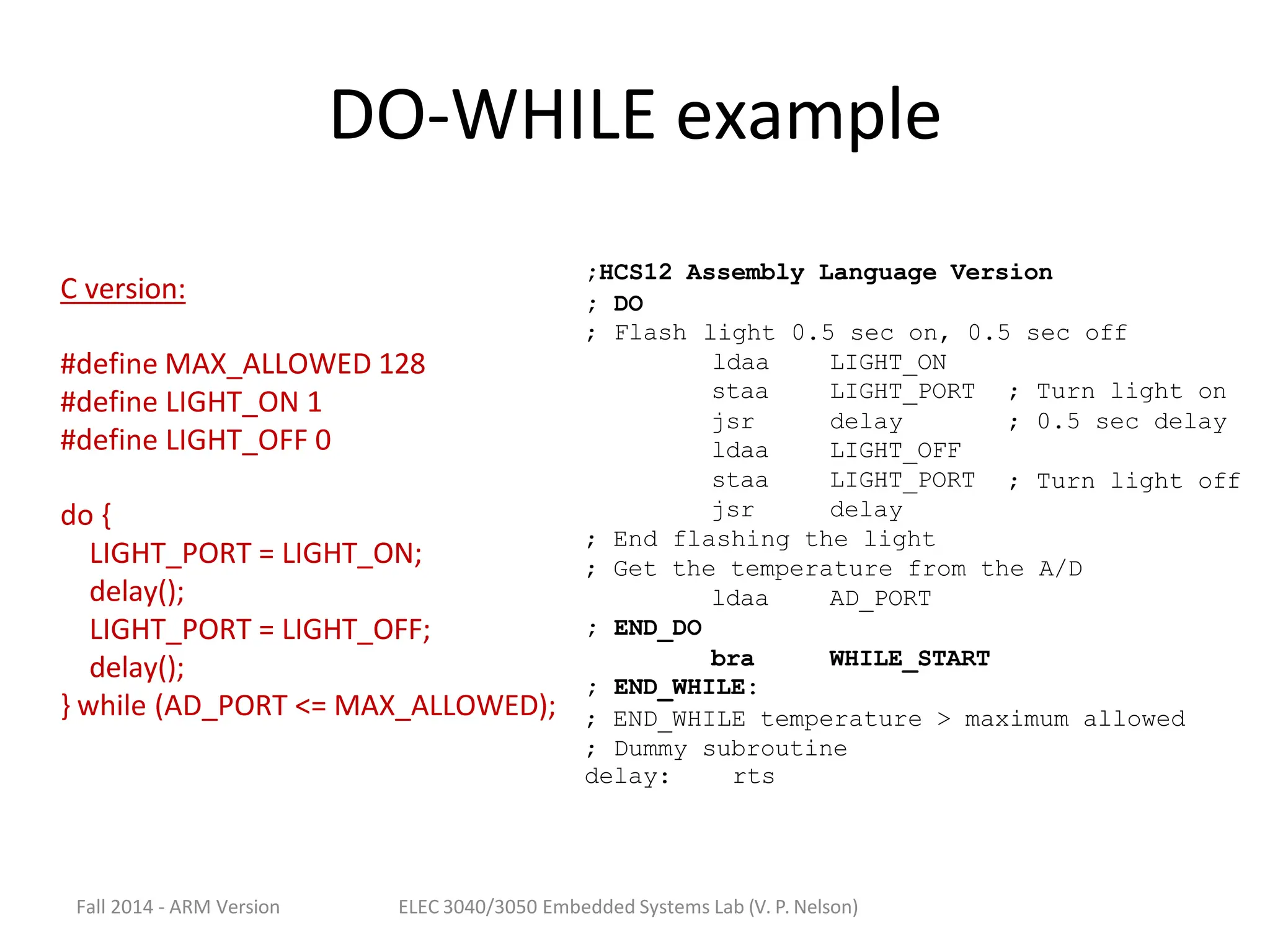
![Fall 2014 - ARM Version ELEC 3040/3050 Embedded Systems Lab (V. P. Nelson)
WHILE examples
/* Add two 200-element arrays. */
int M[200],N[200],P[200];
int k;
/* Method 1 – using DO-WHILE */
//initialize counter/index
k = 0;
do {
M[k] = N[k] + P[k];
k = k + 1;
} while (k < 200);
//add k-th array elements
//increment counter/index
//repeat if k less than 200
/* Method 2 – using WHILE loop
//initialize counter/index
//execute the loop if k less than 200
//add k-th array elements
//increment counter/index
k = 0;
while (k < 200} {
M[k] = N[k] + P[k];
k = k + 1;
}](https://image.slidesharecdn.com/cprogrammingforembeddedsystemapplications-231028123916-aac2e84f/75/C-programming-for-embedded-system-applications-pptx-38-2048.jpg)
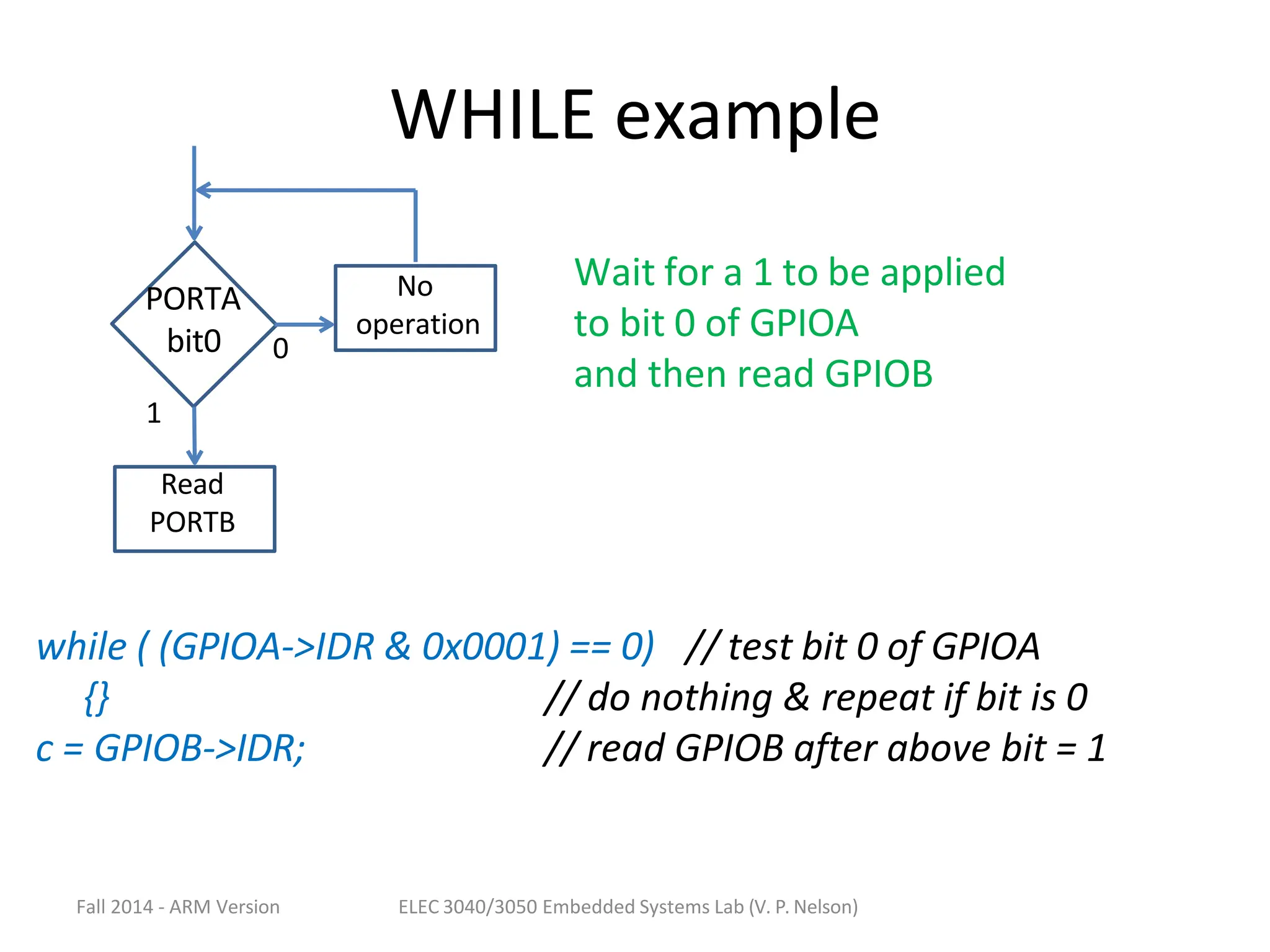
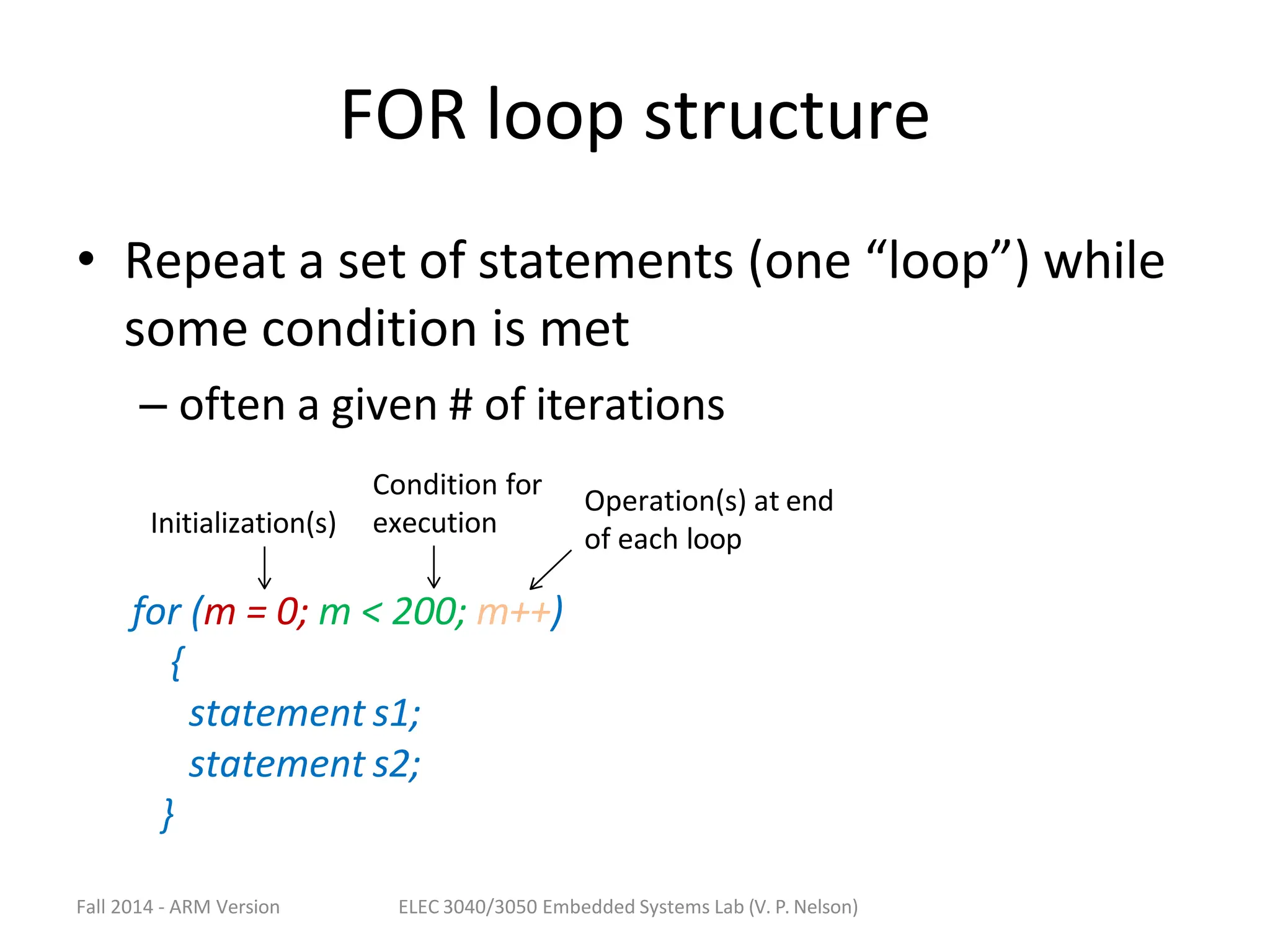
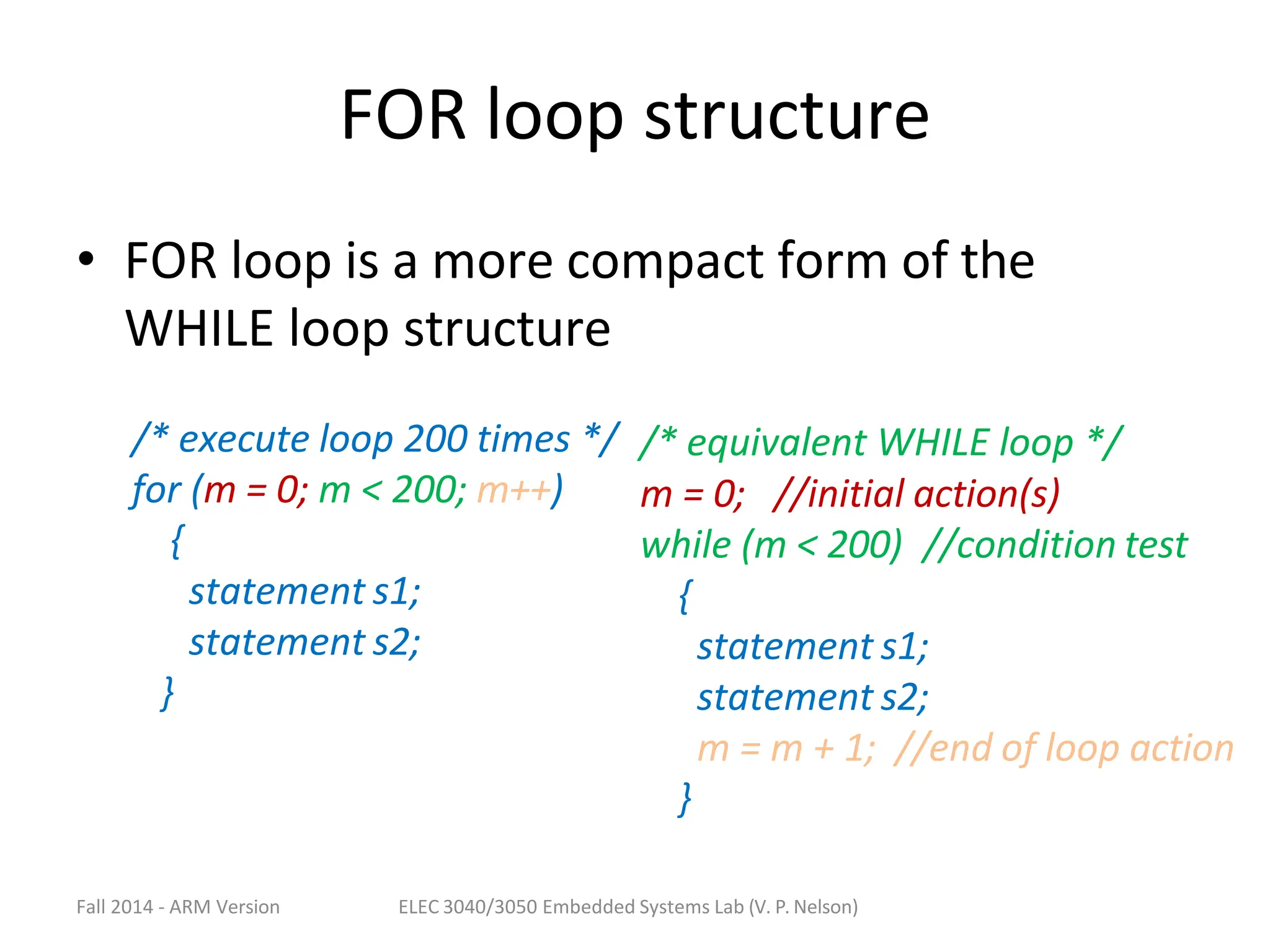
![Fall 2014 - ARM Version ELEC 3040/3050 Embedded Systems Lab (V. P. Nelson)
FOR structure example
/* Read 100 16-bit values from GPIOB into array C */
/* Bit 0 of GPIOA (PA0) is 1 if data is ready, and 0 otherwise */
uint16_t c[100];
uint16_t k;
for (k = 0; k < 200; k++) {
while ((GPIOA->IDR & 0x01) == 0) //repeat until PA0 = 1
{}
c[k] = GPIOB->IDR;
//do nothing if PA0 = 0
//read data from PB[15:0]
}](https://image.slidesharecdn.com/cprogrammingforembeddedsystemapplications-231028123916-aac2e84f/75/C-programming-for-embedded-system-applications-pptx-42-2048.jpg)
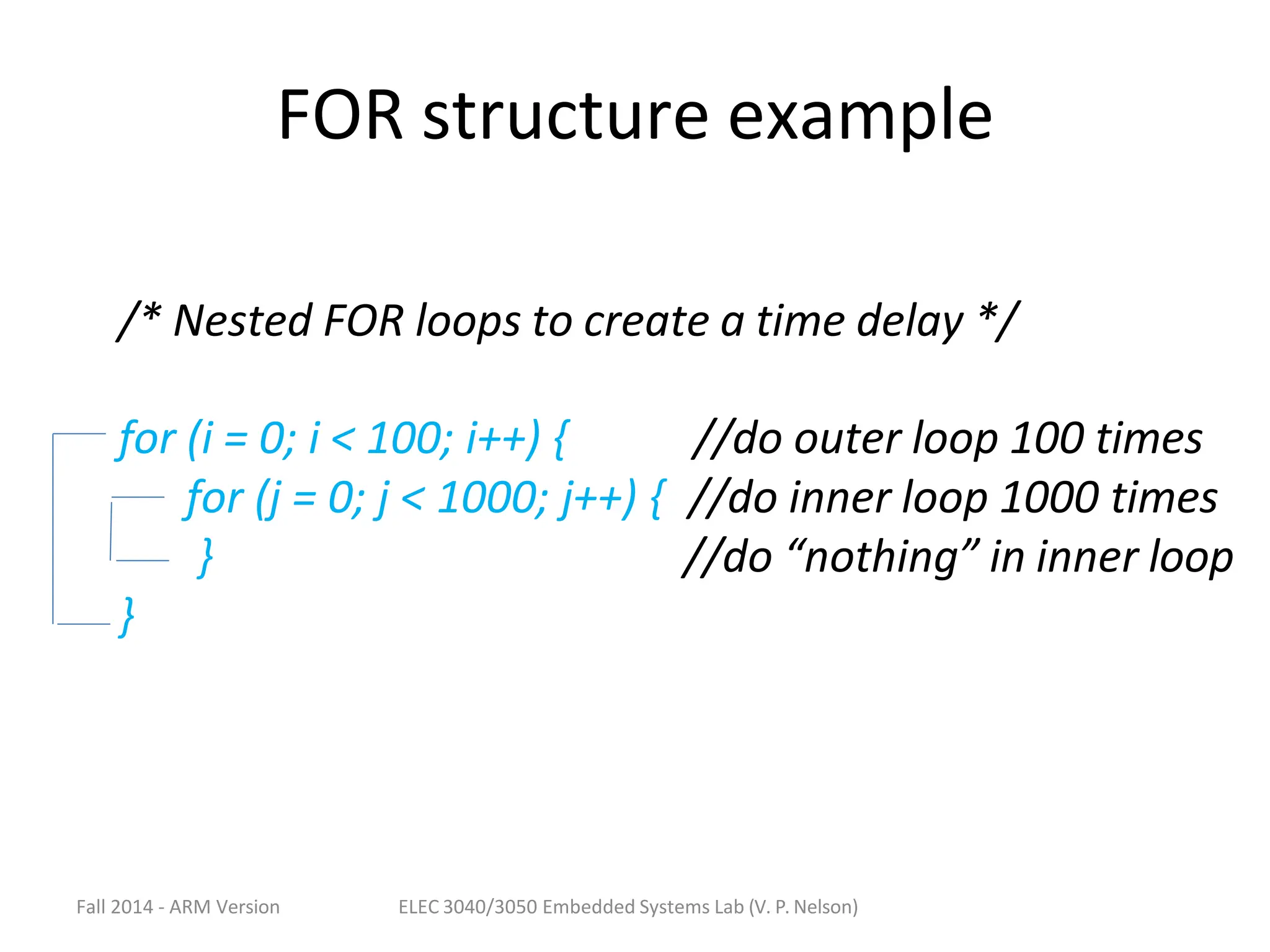
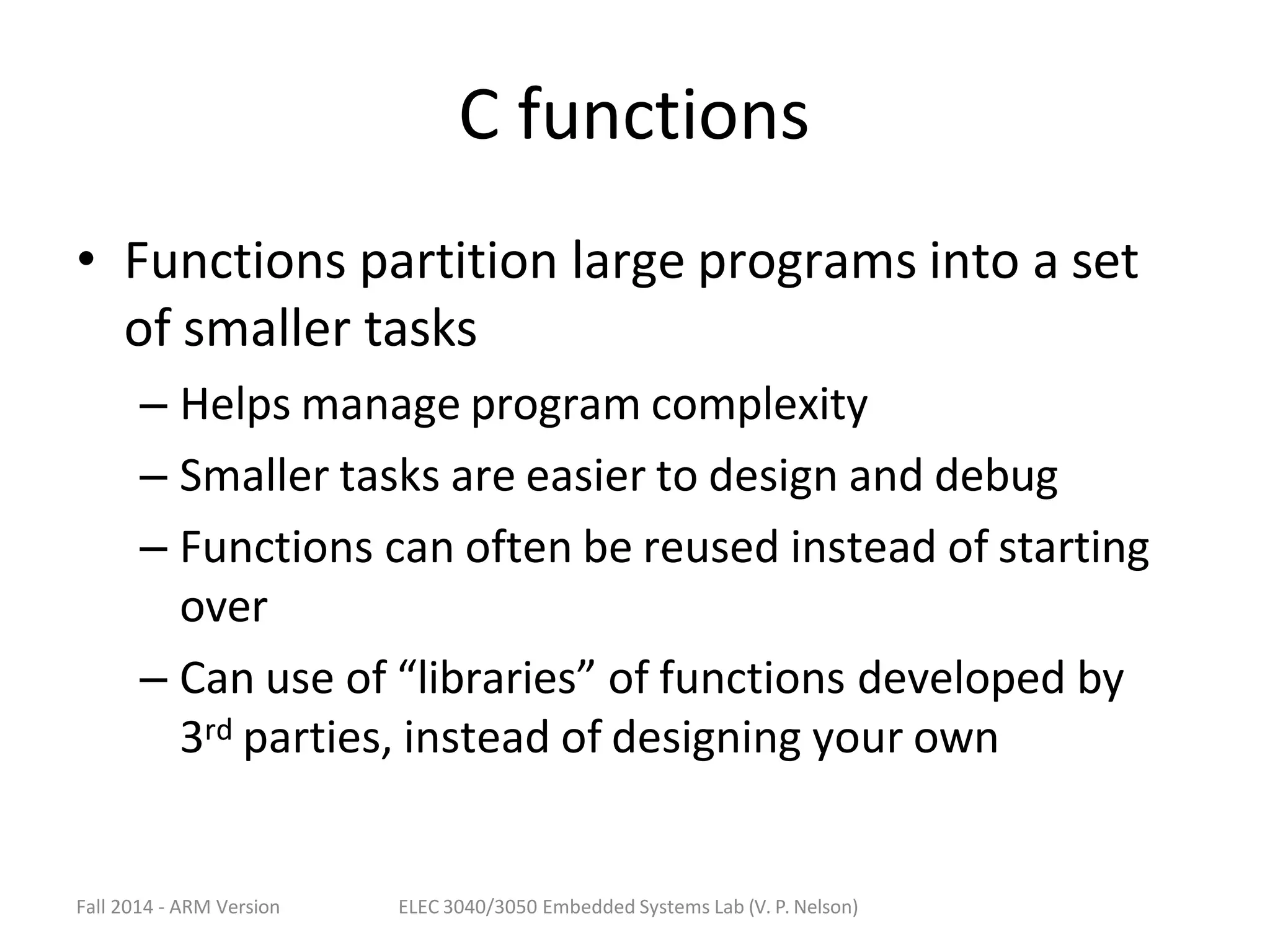
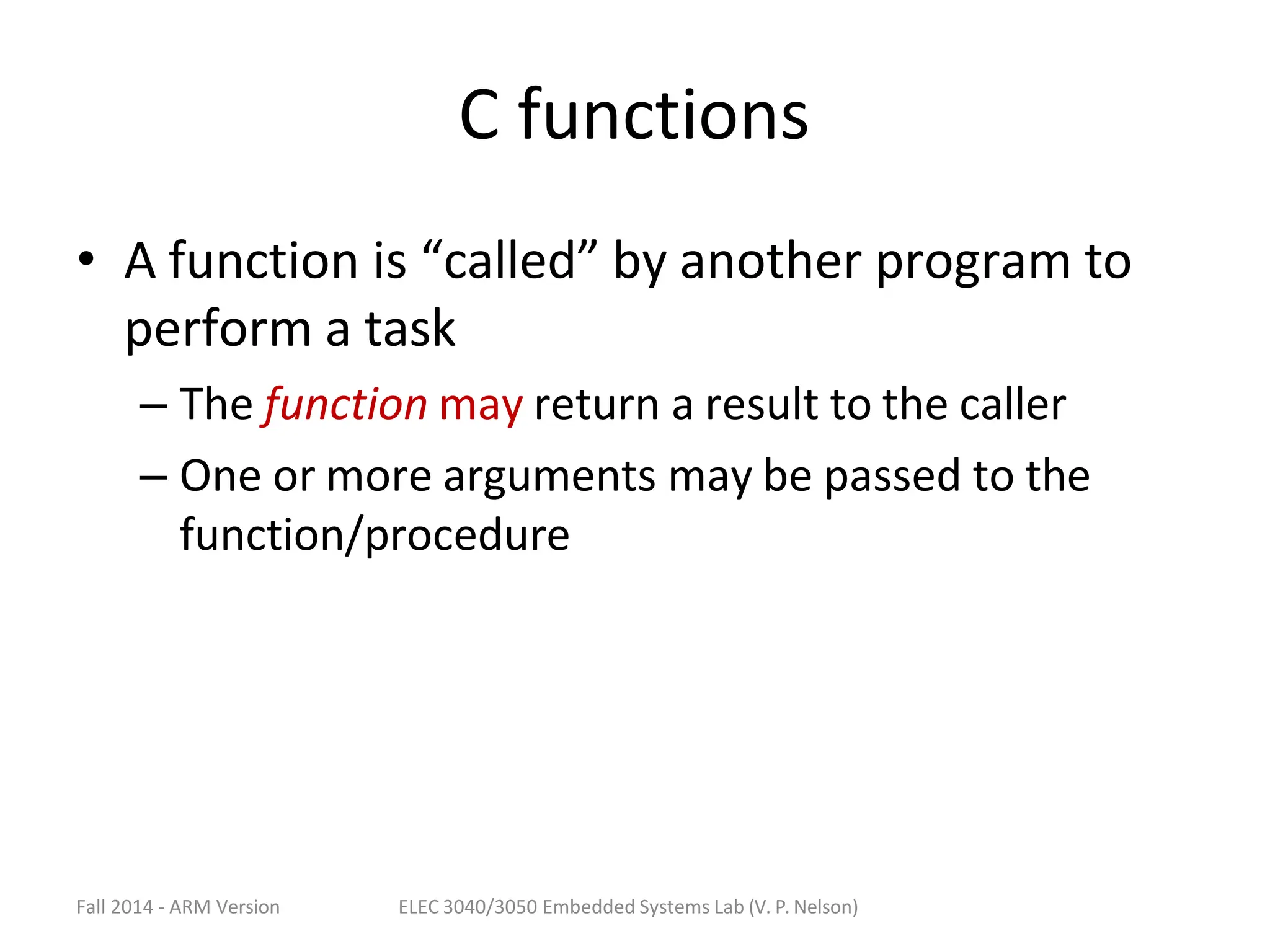
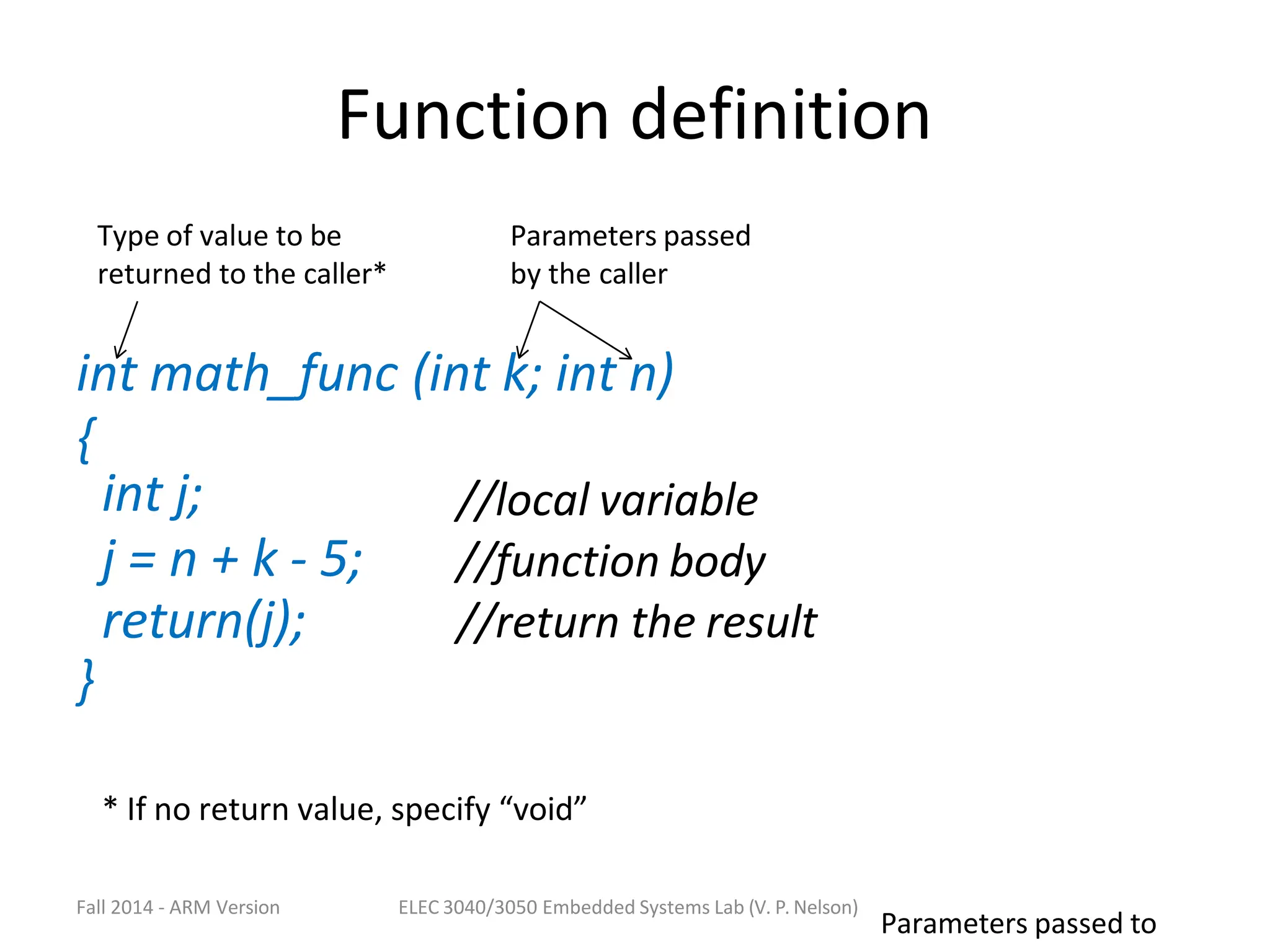
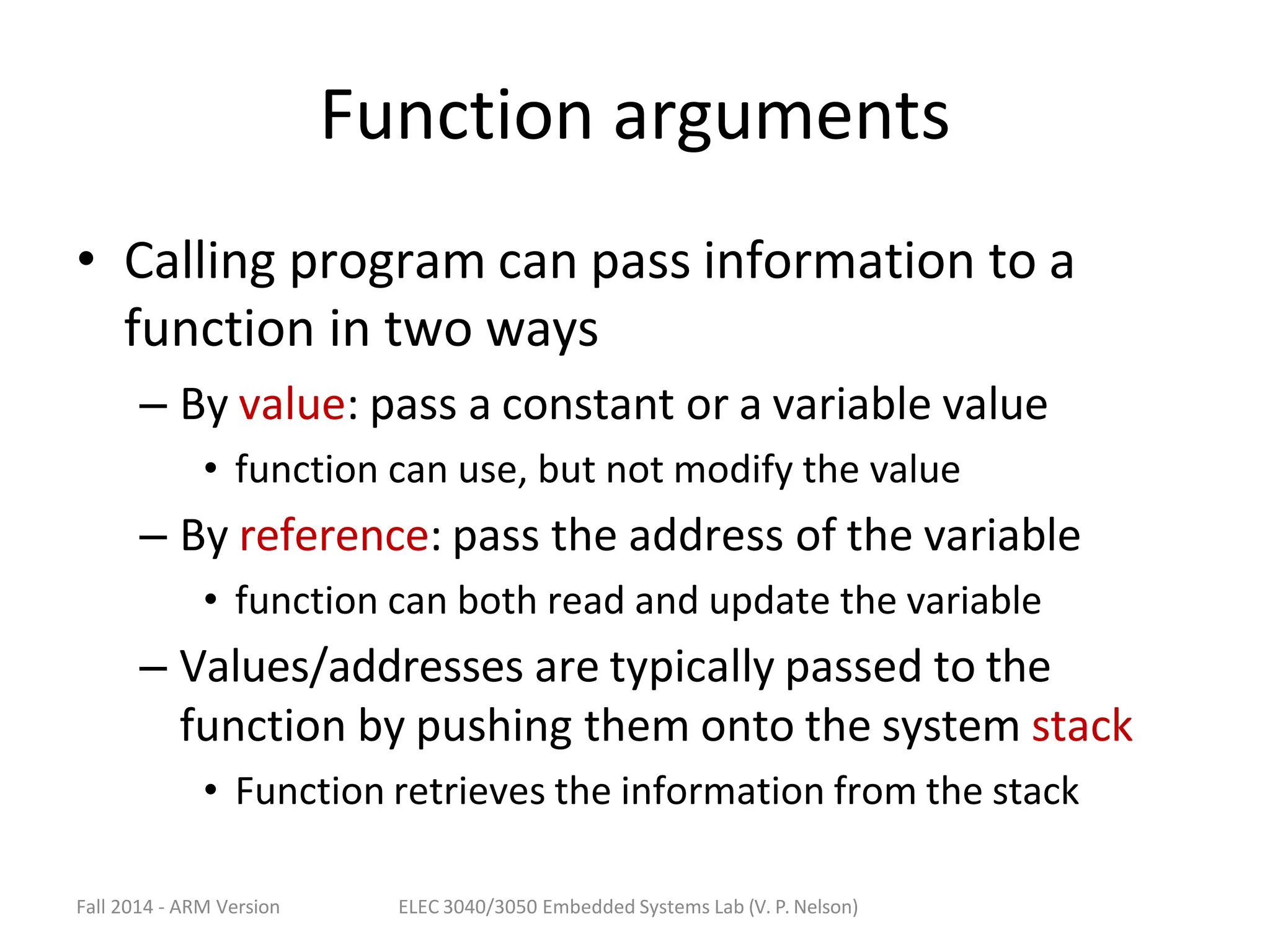
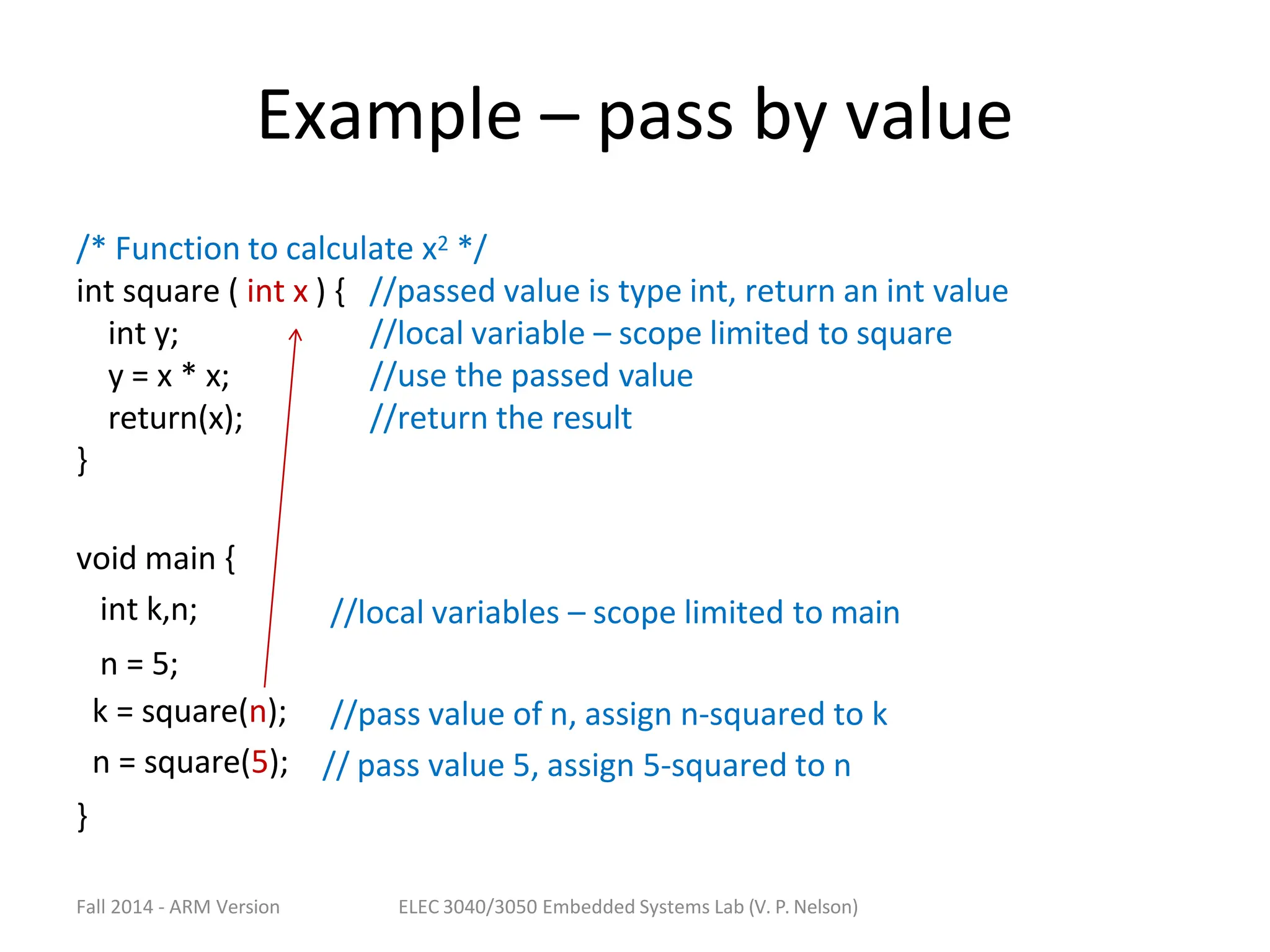
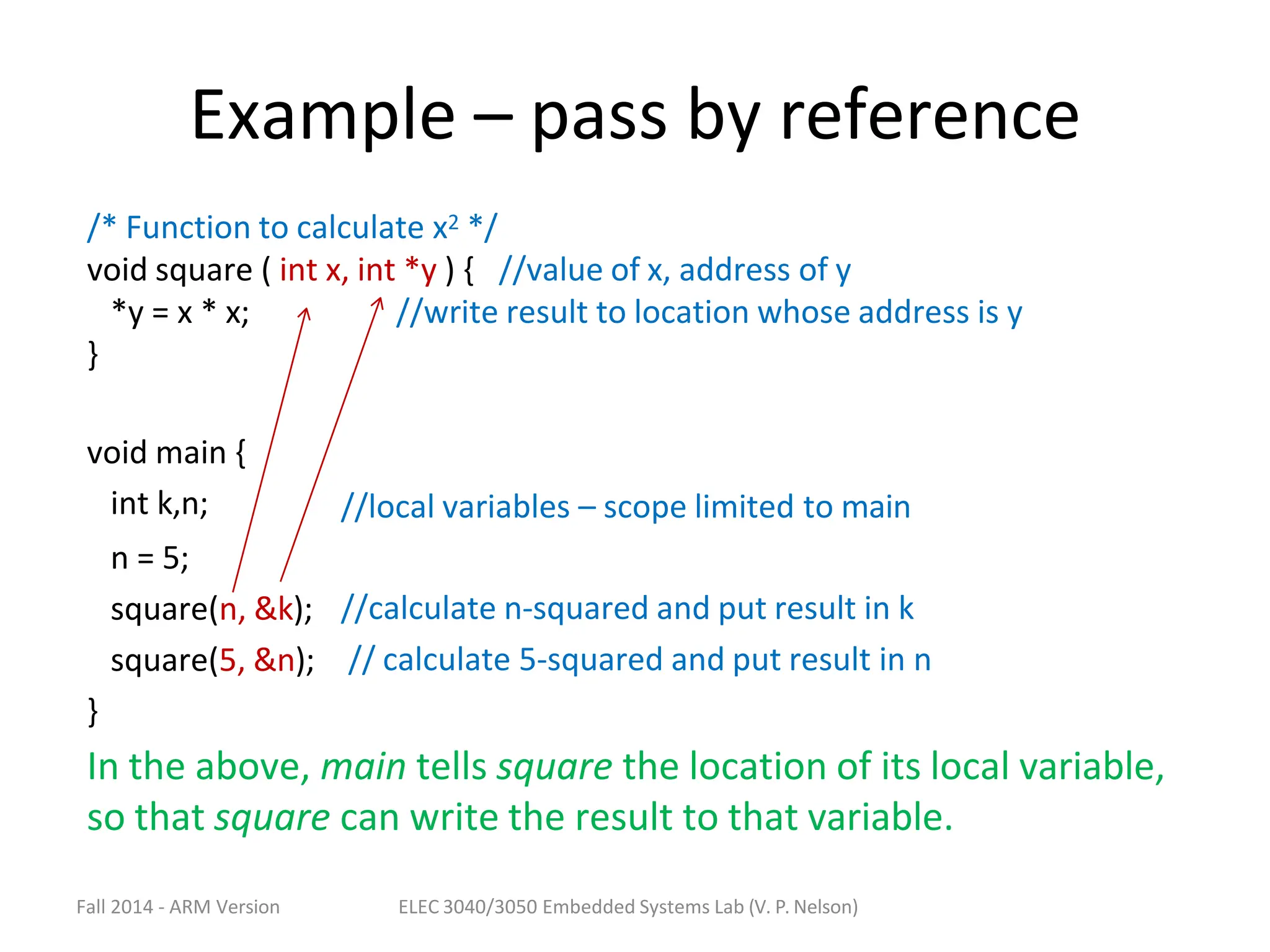
![Fall 2014 - ARM Version ELEC 3040/3050 Embedded Systems Lab (V. P. Nelson)
Example – receive serial data bytes
/* Put string of received SCI bytes into an array */
Int rcv_data[10];
Int rcv_count;
//global variable array for received data
//global variable for #received bytes
void SCI_receive ( ) {
while ( (SCISR1 & 0x20) == 0) {}
rcv_data[rcv_count] = SCIDRL;
rcv_count++;
}
//wait for new data (RDRF = 1)
//byte to array from SCI data reg.
//update index for next byte
Other functions can access the received data from the global variable
array rcv_data[].](https://image.slidesharecdn.com/cprogrammingforembeddedsystemapplications-231028123916-aac2e84f/75/C-programming-for-embedded-system-applications-pptx-50-2048.jpg)
